Paul van Yperen's Blog, page 38
September 20, 2024
Laurent Malet
Laurent Malet (1955) is a renowned French stage, film and TV actor. After his stage debut in 1975 and his film breakthrough with Claude Chabrol's Les Liens du sang/Blood Relatives (1978), Malet worked with many well-known French and foreign film directors such as Joseph Losey, Rainer Werner Fassbinder, Peter Del Monte, Claude Lelouch, Jacques Demy, Andrzej Wajda and Raul Ruiz.
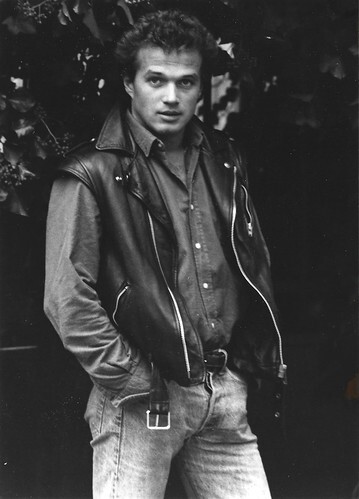
Vintage photo.
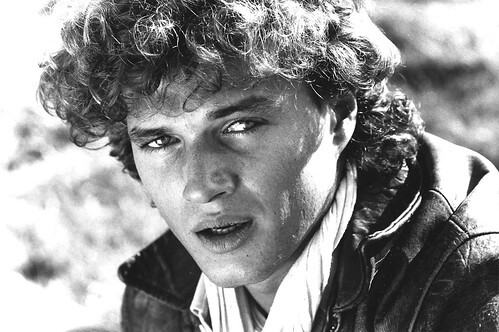
Vintage photo.
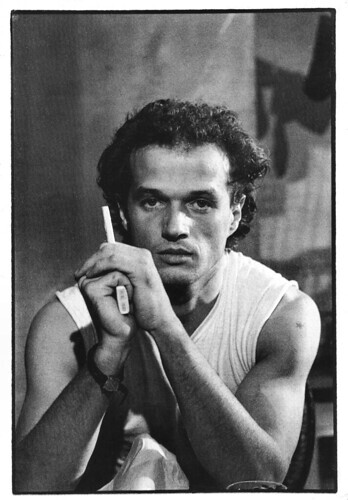
French postcard by Editions Photomania, no. G 50. Photo: J. Prayer / Gamma. Laurent Malet in the French film Tir à vue/Shoot to kill (Marc Angelo, 1984).
One of Fassbinder's most important films
Laurent Malet was born under the full name Laurent Marie Guespin-Malet in 1955 in Bayonne, France. After training with Tsilla Chelto at ENSATT and Blanche Salant at the American Centre in Paris, Malet was hired to play Curd Jürgens ' grandson in the television series La Foire (Pierre Viallet, 1977).
After making his stage debut in 'La guerre de Troie n'aura pas lieu' as Troïlus opposite Claude Jade as Helena in 1975, he went on to star in 1978 as Andrew opposite Donald Sutherland and Stéphane Audran in Claude Chabrol's Canadian-French mystery film Les Liens de sang/Blood Relatives (1978), adapted from the novel by Ed McBain. That same year, Gilles Béhat gave him the lead role in Haro! and he played Yves Montand 's son in Joseph Losey's Les Routes du sud/Roads to the South. He then played Lino Ventura 's son in the Canadian-French drama L'Homme en colère/Jigsaw (Claude Pinoteau, 1979), and Annie Girardot 's son in Le Cœur à l'envers (Franck Apprederis, 1980).
Laurent Malet impressed with his performance as Roger Bataille in Querelle (1982), the last film directed by Rainer Werner Fassbinder , based on Jean Genet's novel 'Querelle de Brest', and starring Brad Davis and Franco Nero . James Travers at French Films in 2011: "Too often dismissed as a pretentious piece of gay erotica, Querelle has only recently (twenty years after its release) come to be regarded in a favourable light and is now widely considered to be one of Fassbinder's most important films."
In the same year, Malet acted in Peter Del Monte's Invitation au voyage (1982), which was awarded at Cannes. In this road movie, he plays a young man who cannot separate himself from his dead twin sister (who is also his beloved) and drives around with her corpse. He also starred alongside Sandrine Bonnaire in Tir à vue/Shoot to kill (Marc Angelo, 1984).
He played alongside Charlotte Rampling in Viva la vie (Claude Lelouch, 1984), alongside Francis Huster and Jean Marais in the French fantasy and musical Parking (1985), directed by Jacques Demy, and again opposite Sandrine Bonnaire in the French-Belgian drama La Puritaine/The Prude (Jacques Doillon, 1986). In 1987, he starred alongside his brother Pierre Malet in Jeanne Labrune's TV film La Part de l'autre. He had already played with his brother in Comme un boomerang (José Giovanni, 1976) with Alain Delon , in which they made a brief appearance.
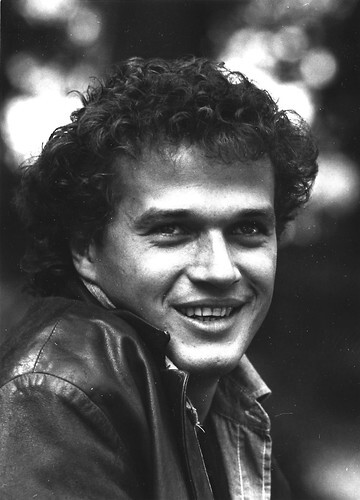
Vintage photo.
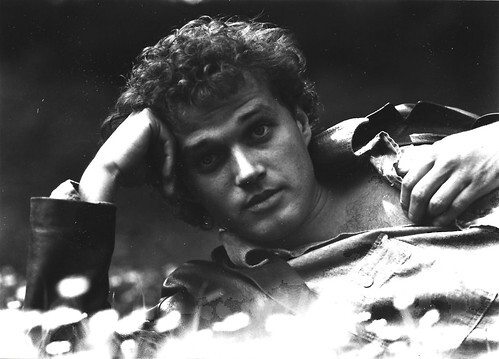
Vintage photo.
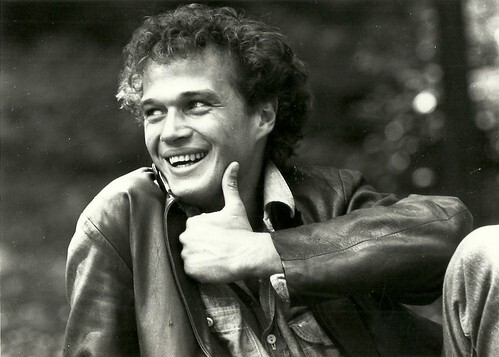
Vintage photo.
The euthanasia of his mother
Laurent Malet played the role of the client alongside Isaac de Bankolé in Bernard-Marie Koltès's play 'Dans la solitude des champs de coton' (1987), directed by Patrice Chéreau at the Théâtre Nanterre-Amandiers. This performance was followed by a European tour and a television broadcast directed by Benoît Jacquot. Acclaimed was his performance as Kirilov opposite Isabelle Huppert in Andrzej Wajda's French drama Les Possédés/The Possessed (1988), based on the novel by Fyodor Dostoyevsky. He returned to the stage in 1989 to star in 'Le Transport amoureux', directed by Antoine Vitez at the Théâtre de l'Odéon.
In 1994, he tried his hand at directing, making the short film Au nom d'un chien based on 'Jérôme', a short story by Louis Hémon, starring Jean-Marc Barr . Malet played Arthur Rimbaud twice, first in the TV film L'Homme aux semelles de vent (Marc Rivière, 1995), then in the play 'Rimbaud, dernière escale'(1999), which he co-wrote and premiered at the Théâtre Molière/Maison de la Poésie. In 2003, he starred alongside Bernard Giraudeau in the Swiss-French absurdist black comedy Ce jour-là/That Day by Chilean filmmaker Raoul Ruiz. He reunited with the director for La Maison Nucingen (Raul Ruiz, 2008). In addition to stage and screen, Malet has also acted in several TV films and TV series. He mostly appeared in one episode, but in the Italian TV series Cuore by Luigi Comencini, he had a lead in all six episodes. He played the adult Enrico Bottini, opposite Johnny Dorelli as Maestro Perboni and Carlo Calenda as young Enrico.
He also acted as Michel le Fresne in five of the six episodes of the war drama The Free Frenchman (Jon Goddard, 1989), starring Derek de Lint and based on the book by Piers Paul Read. Most recently, he acted as Papa Charly in all eight episodes of the Science-Fiction mini-series Section Zéro (Olivier Marchal, 2016).
Laurent Malet is the son of Florence Malet and Jean-Jacques Guespin. His twin brother, actor Pierre Malet, also goes by the pseudonym (Pierre) Marie Guespin-Malet. He is also the half-brother of Olivier, Lison and Charlotte Guespin, whose mother, Geneviève Galéa, is also the mother of, among others, Emmanuelle Béart . Very attached to his brother and his mother, whose name he usually bears alone, Malet was asked by his mother, who was suffering from terminal brain cancer, to put an end to her suffering. He recounts this story in his book 'En attendant la suite', published in 2007. At the time, Malet called on the presidential candidates to legislate on euthanasia. Laurent Malet has shared his life with actress Isabelle Renauld since 1987. They have a son, Théo, born in 1988.
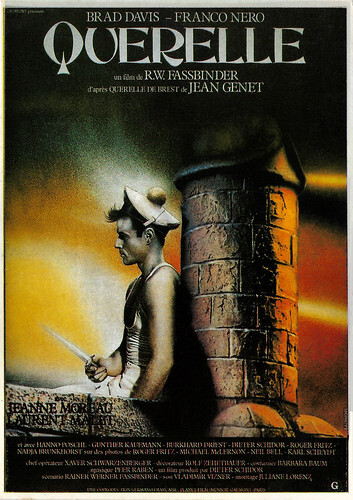
Vintage postcard. French poster by Benjamin Baltimore / Gaumont for Querelle (Rainer Werner Fassbinder, 1982) with Brad Davis.
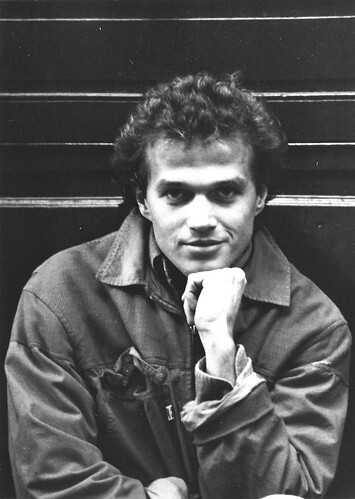
Vintage photo.
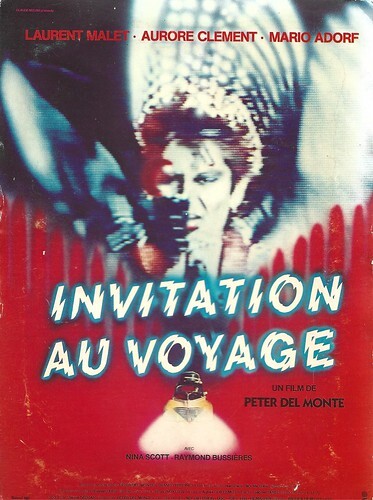
French postcard by Imprimerie Soccodim, Sartrouville. Poster design by Razzia. Poster for Invitation au voyage (Peter Del Monte, 1982) with Laurent Malet.
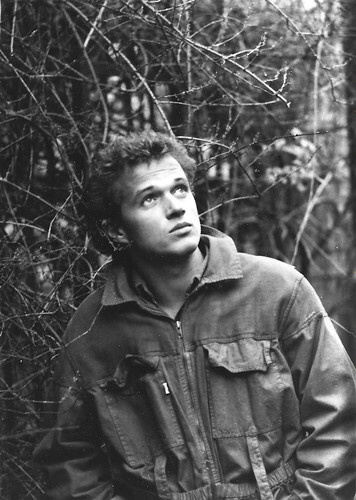
Vintage photo.
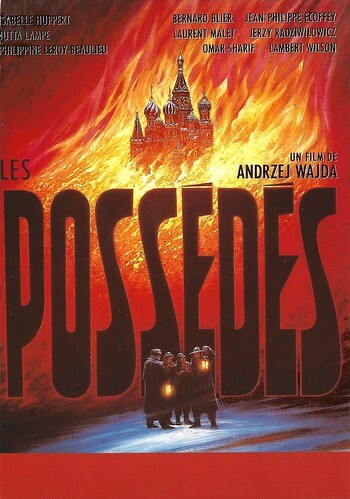
French postcard by Editions F. Nugeron, no. E 478. French poster for Les Possédés (Andrzej Wajda, 1988), starring Lambert Wilson, Isabelle Huppert, Jutta Lampe, Omar Sharif, Laurent Malet, and based on the novel by Fyodor Dostoevsky.
Sources: James Travers (French Films), Wikipedia (French and English), and .

Vintage photo.

Vintage photo.

French postcard by Editions Photomania, no. G 50. Photo: J. Prayer / Gamma. Laurent Malet in the French film Tir à vue/Shoot to kill (Marc Angelo, 1984).
One of Fassbinder's most important films
Laurent Malet was born under the full name Laurent Marie Guespin-Malet in 1955 in Bayonne, France. After training with Tsilla Chelto at ENSATT and Blanche Salant at the American Centre in Paris, Malet was hired to play Curd Jürgens ' grandson in the television series La Foire (Pierre Viallet, 1977).
After making his stage debut in 'La guerre de Troie n'aura pas lieu' as Troïlus opposite Claude Jade as Helena in 1975, he went on to star in 1978 as Andrew opposite Donald Sutherland and Stéphane Audran in Claude Chabrol's Canadian-French mystery film Les Liens de sang/Blood Relatives (1978), adapted from the novel by Ed McBain. That same year, Gilles Béhat gave him the lead role in Haro! and he played Yves Montand 's son in Joseph Losey's Les Routes du sud/Roads to the South. He then played Lino Ventura 's son in the Canadian-French drama L'Homme en colère/Jigsaw (Claude Pinoteau, 1979), and Annie Girardot 's son in Le Cœur à l'envers (Franck Apprederis, 1980).
Laurent Malet impressed with his performance as Roger Bataille in Querelle (1982), the last film directed by Rainer Werner Fassbinder , based on Jean Genet's novel 'Querelle de Brest', and starring Brad Davis and Franco Nero . James Travers at French Films in 2011: "Too often dismissed as a pretentious piece of gay erotica, Querelle has only recently (twenty years after its release) come to be regarded in a favourable light and is now widely considered to be one of Fassbinder's most important films."
In the same year, Malet acted in Peter Del Monte's Invitation au voyage (1982), which was awarded at Cannes. In this road movie, he plays a young man who cannot separate himself from his dead twin sister (who is also his beloved) and drives around with her corpse. He also starred alongside Sandrine Bonnaire in Tir à vue/Shoot to kill (Marc Angelo, 1984).
He played alongside Charlotte Rampling in Viva la vie (Claude Lelouch, 1984), alongside Francis Huster and Jean Marais in the French fantasy and musical Parking (1985), directed by Jacques Demy, and again opposite Sandrine Bonnaire in the French-Belgian drama La Puritaine/The Prude (Jacques Doillon, 1986). In 1987, he starred alongside his brother Pierre Malet in Jeanne Labrune's TV film La Part de l'autre. He had already played with his brother in Comme un boomerang (José Giovanni, 1976) with Alain Delon , in which they made a brief appearance.

Vintage photo.

Vintage photo.

Vintage photo.
The euthanasia of his mother
Laurent Malet played the role of the client alongside Isaac de Bankolé in Bernard-Marie Koltès's play 'Dans la solitude des champs de coton' (1987), directed by Patrice Chéreau at the Théâtre Nanterre-Amandiers. This performance was followed by a European tour and a television broadcast directed by Benoît Jacquot. Acclaimed was his performance as Kirilov opposite Isabelle Huppert in Andrzej Wajda's French drama Les Possédés/The Possessed (1988), based on the novel by Fyodor Dostoyevsky. He returned to the stage in 1989 to star in 'Le Transport amoureux', directed by Antoine Vitez at the Théâtre de l'Odéon.
In 1994, he tried his hand at directing, making the short film Au nom d'un chien based on 'Jérôme', a short story by Louis Hémon, starring Jean-Marc Barr . Malet played Arthur Rimbaud twice, first in the TV film L'Homme aux semelles de vent (Marc Rivière, 1995), then in the play 'Rimbaud, dernière escale'(1999), which he co-wrote and premiered at the Théâtre Molière/Maison de la Poésie. In 2003, he starred alongside Bernard Giraudeau in the Swiss-French absurdist black comedy Ce jour-là/That Day by Chilean filmmaker Raoul Ruiz. He reunited with the director for La Maison Nucingen (Raul Ruiz, 2008). In addition to stage and screen, Malet has also acted in several TV films and TV series. He mostly appeared in one episode, but in the Italian TV series Cuore by Luigi Comencini, he had a lead in all six episodes. He played the adult Enrico Bottini, opposite Johnny Dorelli as Maestro Perboni and Carlo Calenda as young Enrico.
He also acted as Michel le Fresne in five of the six episodes of the war drama The Free Frenchman (Jon Goddard, 1989), starring Derek de Lint and based on the book by Piers Paul Read. Most recently, he acted as Papa Charly in all eight episodes of the Science-Fiction mini-series Section Zéro (Olivier Marchal, 2016).
Laurent Malet is the son of Florence Malet and Jean-Jacques Guespin. His twin brother, actor Pierre Malet, also goes by the pseudonym (Pierre) Marie Guespin-Malet. He is also the half-brother of Olivier, Lison and Charlotte Guespin, whose mother, Geneviève Galéa, is also the mother of, among others, Emmanuelle Béart . Very attached to his brother and his mother, whose name he usually bears alone, Malet was asked by his mother, who was suffering from terminal brain cancer, to put an end to her suffering. He recounts this story in his book 'En attendant la suite', published in 2007. At the time, Malet called on the presidential candidates to legislate on euthanasia. Laurent Malet has shared his life with actress Isabelle Renauld since 1987. They have a son, Théo, born in 1988.

Vintage postcard. French poster by Benjamin Baltimore / Gaumont for Querelle (Rainer Werner Fassbinder, 1982) with Brad Davis.

Vintage photo.

French postcard by Imprimerie Soccodim, Sartrouville. Poster design by Razzia. Poster for Invitation au voyage (Peter Del Monte, 1982) with Laurent Malet.

Vintage photo.

French postcard by Editions F. Nugeron, no. E 478. French poster for Les Possédés (Andrzej Wajda, 1988), starring Lambert Wilson, Isabelle Huppert, Jutta Lampe, Omar Sharif, Laurent Malet, and based on the novel by Fyodor Dostoevsky.
Sources: James Travers (French Films), Wikipedia (French and English), and .
Published on September 20, 2024 22:00
Laurent Mallet
Laurent Malet (1955) is a renowned French stage, film and TV actor. After his stage debut in 1975 and his film breakthrough with Claude Chabrol's Les Liens du sang/Blood Relatives (1978), Malet worked with many well-known French and foreign film directors such as Joseph Losey, Rainer Werner Fassbinder, Peter Del Monte, Claude Lelouch, Jacques Demy, Andrzej Wajda and Raul Ruiz.

Vintage photo.

Vintage photo.

French postcard by Editions Photomania, no. G 50. Photo: J. Prayer / Gamma. Laurent Malet in the French film Tir à vue/Shoot to kill (Marc Angelo, 1984).
One of Fassbinder's most important films
Laurent Malet was born under the full name Laurent Marie Guespin-Malet in 1955 in Bayonne, France. After training with Tsilla Chelto at ENSATT and Blanche Salant at the American Centre in Paris, Malet was hired to play Curd Jürgens ' grandson in the television series La Foire (Pierre Viallet, 1977).
After making his stage debut in 'La guerre de Troie n'aura pas lieu' as Troïlus opposite Claude Jade as Helena in 1975, he went on to star in 1978 as Andrew opposite Donald Sutherland and Stéphane Audran in Claude Chabrol's Canadian-French mystery film Les Liens de sang/Blood Relatives (1978), adapted from the novel by Ed McBain. That same year, Gilles Béhat gave him the lead role in Haro! and he played Yves Montand 's son in Joseph Losey's Les Routes du sud/Roads to the South. He then played Lino Ventura 's son in the Canadian-French drama L'Homme en colère/Jigsaw (Claude Pinoteau, 1979), and Annie Girardot 's son in Le Cœur à l'envers (Franck Apprederis, 1980).
Laurent Malet impressed with his performance as Roger Bataille in Querelle (1982), the last film directed by Rainer Werner Fassbinder , based on Jean Genet's novel 'Querelle de Brest', and starring Brad Davis and Franco Nero . James Travers at French Films in 2011: "Too often dismissed as a pretentious piece of gay erotica, Querelle has only recently (twenty years after its release) come to be regarded in a favourable light and is now widely considered to be one of Fassbinder's most important films."
In the same year, Malet acted in Peter Del Monte's Invitation au voyage (1982), which was awarded at Cannes. In this road movie, he plays a young man who cannot separate himself from his dead twin sister (who is also his beloved) and drives around with her corpse. He also starred alongside Sandrine Bonnaire in Tir à vue/Shoot to kill (Marc Angelo, 1984).
He played alongside Charlotte Rampling in Viva la vie (Claude Lelouch, 1984), alongside Francis Huster and Jean Marais in the French fantasy and musical Parking (1985), directed by Jacques Demy, and again opposite Sandrine Bonnaire in the French-Belgian drama La Puritaine/The Prude (Jacques Doillon, 1986). In 1987, he starred alongside his brother Pierre Malet in Jeanne Labrune's TV film La Part de l'autre. He had already played with his brother in Comme un boomerang (José Giovanni, 1976) with Alain Delon , in which they made a brief appearance.

Vintage photo.

Vintage photo.

Vintage photo.
The euthanasia of his mother
Laurent Malet played the role of the client alongside Isaac de Bankolé in Bernard-Marie Koltès's play 'Dans la solitude des champs de coton' (1987), directed by Patrice Chéreau at the Théâtre Nanterre-Amandiers. This performance was followed by a European tour and a television broadcast directed by Benoît Jacquot. Acclaimed was his performance as Kirilov opposite Isabelle Huppert in Andrzej Wajda's French drama Les Possédés/The Possessed (1988), based on the novel by Fyodor Dostoyevsky. He returned to the stage in 1989 to star in 'Le Transport amoureux', directed by Antoine Vitez at the Théâtre de l'Odéon.
In 1994, he tried his hand at directing, making the short film Au nom d'un chien based on 'Jérôme', a short story by Louis Hémon, starring Jean-Marc Barr . Malet played Arthur Rimbaud twice, first in the TV film L'Homme aux semelles de vent (Marc Rivière, 1995), then in the play 'Rimbaud, dernière escale'(1999), which he co-wrote and premiered at the Théâtre Molière/Maison de la Poésie. In 2003, he starred alongside Bernard Giraudeau in the Swiss-French absurdist black comedy Ce jour-là/That Day by Chilean filmmaker Raoul Ruiz. He reunited with the director for La Maison Nucingen (Raul Ruiz, 2008). In addition to stage and screen, Malet has also acted in several TV films and TV series. He mostly appeared in one episode, but in the Italian TV series Cuore by Luigi Comencini, he had a lead in all six episodes. He played the adult Enrico Bottini, opposite Johnny Dorelli as Maestro Perboni and Carlo Calenda as young Enrico.
He also acted as Michel le Fresne in five of the six episodes of the war drama The Free Frenchman (Jon Goddard, 1989), starring Derek de Lint and based on the book by Piers Paul Read. Most recently, he acted as Papa Charly in all eight episodes of the Science-Fiction mini-series Section Zéro (Olivier Marchal, 2016).
Laurent Malet is the son of Florence Malet and Jean-Jacques Guespin. His twin brother, actor Pierre Malet, also goes by the pseudonym (Pierre) Marie Guespin-Malet. He is also the half-brother of Olivier, Lison and Charlotte Guespin, whose mother, Geneviève Galéa, is also the mother of, among others, Emmanuelle Béart . Very attached to his brother and his mother, whose name he usually bears alone, Malet was asked by his mother, who was suffering from terminal brain cancer, to put an end to her suffering. He recounts this story in his book 'En attendant la suite', published in 2007. At the time, Malet called on the presidential candidates to legislate on euthanasia. Laurent Malet has shared his life with actress Isabelle Renauld since 1987. They have a son, Théo, born in 1988.

Vintage postcard. French poster by Benjamin Baltimore / Gaumont for Querelle (Rainer Werner Fassbinder, 1982) with Brad Davis.

Vintage photo.

French postcard by Imprimerie Soccodim, Sartrouville. Poster design by Razzia. Poster for Invitation au voyage (Peter Del Monte, 1982) with Laurent Malet.

Vintage photo.

French postcard by Editions F. Nugeron, no. E 478. French poster for Les Possédés (Andrzej Wajda, 1988), starring Lambert Wilson, Isabelle Huppert, Jutta Lampe, Omar Sharif, Laurent Malet, and based on the novel by Fyodor Dostoevsky.
Sources: James Travers (French Films), Wikipedia (French and English), and .

Vintage photo.

Vintage photo.

French postcard by Editions Photomania, no. G 50. Photo: J. Prayer / Gamma. Laurent Malet in the French film Tir à vue/Shoot to kill (Marc Angelo, 1984).
One of Fassbinder's most important films
Laurent Malet was born under the full name Laurent Marie Guespin-Malet in 1955 in Bayonne, France. After training with Tsilla Chelto at ENSATT and Blanche Salant at the American Centre in Paris, Malet was hired to play Curd Jürgens ' grandson in the television series La Foire (Pierre Viallet, 1977).
After making his stage debut in 'La guerre de Troie n'aura pas lieu' as Troïlus opposite Claude Jade as Helena in 1975, he went on to star in 1978 as Andrew opposite Donald Sutherland and Stéphane Audran in Claude Chabrol's Canadian-French mystery film Les Liens de sang/Blood Relatives (1978), adapted from the novel by Ed McBain. That same year, Gilles Béhat gave him the lead role in Haro! and he played Yves Montand 's son in Joseph Losey's Les Routes du sud/Roads to the South. He then played Lino Ventura 's son in the Canadian-French drama L'Homme en colère/Jigsaw (Claude Pinoteau, 1979), and Annie Girardot 's son in Le Cœur à l'envers (Franck Apprederis, 1980).
Laurent Malet impressed with his performance as Roger Bataille in Querelle (1982), the last film directed by Rainer Werner Fassbinder , based on Jean Genet's novel 'Querelle de Brest', and starring Brad Davis and Franco Nero . James Travers at French Films in 2011: "Too often dismissed as a pretentious piece of gay erotica, Querelle has only recently (twenty years after its release) come to be regarded in a favourable light and is now widely considered to be one of Fassbinder's most important films."
In the same year, Malet acted in Peter Del Monte's Invitation au voyage (1982), which was awarded at Cannes. In this road movie, he plays a young man who cannot separate himself from his dead twin sister (who is also his beloved) and drives around with her corpse. He also starred alongside Sandrine Bonnaire in Tir à vue/Shoot to kill (Marc Angelo, 1984).
He played alongside Charlotte Rampling in Viva la vie (Claude Lelouch, 1984), alongside Francis Huster and Jean Marais in the French fantasy and musical Parking (1985), directed by Jacques Demy, and again opposite Sandrine Bonnaire in the French-Belgian drama La Puritaine/The Prude (Jacques Doillon, 1986). In 1987, he starred alongside his brother Pierre Malet in Jeanne Labrune's TV film La Part de l'autre. He had already played with his brother in Comme un boomerang (José Giovanni, 1976) with Alain Delon , in which they made a brief appearance.

Vintage photo.

Vintage photo.

Vintage photo.
The euthanasia of his mother
Laurent Malet played the role of the client alongside Isaac de Bankolé in Bernard-Marie Koltès's play 'Dans la solitude des champs de coton' (1987), directed by Patrice Chéreau at the Théâtre Nanterre-Amandiers. This performance was followed by a European tour and a television broadcast directed by Benoît Jacquot. Acclaimed was his performance as Kirilov opposite Isabelle Huppert in Andrzej Wajda's French drama Les Possédés/The Possessed (1988), based on the novel by Fyodor Dostoyevsky. He returned to the stage in 1989 to star in 'Le Transport amoureux', directed by Antoine Vitez at the Théâtre de l'Odéon.
In 1994, he tried his hand at directing, making the short film Au nom d'un chien based on 'Jérôme', a short story by Louis Hémon, starring Jean-Marc Barr . Malet played Arthur Rimbaud twice, first in the TV film L'Homme aux semelles de vent (Marc Rivière, 1995), then in the play 'Rimbaud, dernière escale'(1999), which he co-wrote and premiered at the Théâtre Molière/Maison de la Poésie. In 2003, he starred alongside Bernard Giraudeau in the Swiss-French absurdist black comedy Ce jour-là/That Day by Chilean filmmaker Raoul Ruiz. He reunited with the director for La Maison Nucingen (Raul Ruiz, 2008). In addition to stage and screen, Malet has also acted in several TV films and TV series. He mostly appeared in one episode, but in the Italian TV series Cuore by Luigi Comencini, he had a lead in all six episodes. He played the adult Enrico Bottini, opposite Johnny Dorelli as Maestro Perboni and Carlo Calenda as young Enrico.
He also acted as Michel le Fresne in five of the six episodes of the war drama The Free Frenchman (Jon Goddard, 1989), starring Derek de Lint and based on the book by Piers Paul Read. Most recently, he acted as Papa Charly in all eight episodes of the Science-Fiction mini-series Section Zéro (Olivier Marchal, 2016).
Laurent Malet is the son of Florence Malet and Jean-Jacques Guespin. His twin brother, actor Pierre Malet, also goes by the pseudonym (Pierre) Marie Guespin-Malet. He is also the half-brother of Olivier, Lison and Charlotte Guespin, whose mother, Geneviève Galéa, is also the mother of, among others, Emmanuelle Béart . Very attached to his brother and his mother, whose name he usually bears alone, Malet was asked by his mother, who was suffering from terminal brain cancer, to put an end to her suffering. He recounts this story in his book 'En attendant la suite', published in 2007. At the time, Malet called on the presidential candidates to legislate on euthanasia. Laurent Malet has shared his life with actress Isabelle Renauld since 1987. They have a son, Théo, born in 1988.

Vintage postcard. French poster by Benjamin Baltimore / Gaumont for Querelle (Rainer Werner Fassbinder, 1982) with Brad Davis.

Vintage photo.

French postcard by Imprimerie Soccodim, Sartrouville. Poster design by Razzia. Poster for Invitation au voyage (Peter Del Monte, 1982) with Laurent Malet.

Vintage photo.

French postcard by Editions F. Nugeron, no. E 478. French poster for Les Possédés (Andrzej Wajda, 1988), starring Lambert Wilson, Isabelle Huppert, Jutta Lampe, Omar Sharif, Laurent Malet, and based on the novel by Fyodor Dostoevsky.
Sources: James Travers (French Films), Wikipedia (French and English), and .
Published on September 20, 2024 22:00
September 19, 2024
Estelle Taylor
Estelle Taylor (1894–1958) was an American actress, singer, model, and animal rights activist. With dark-brown, almost black hair, and brown eyes, she was regarded as one of the most beautiful silent film stars of the 1920s.
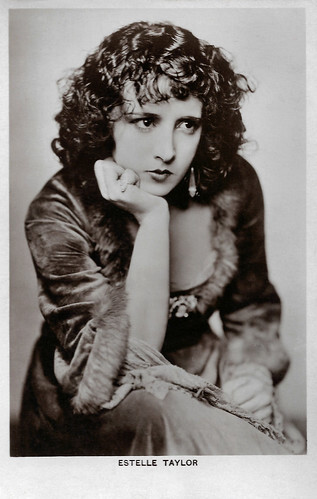
British postcard in the Picturegoer Series, London, no. 219.
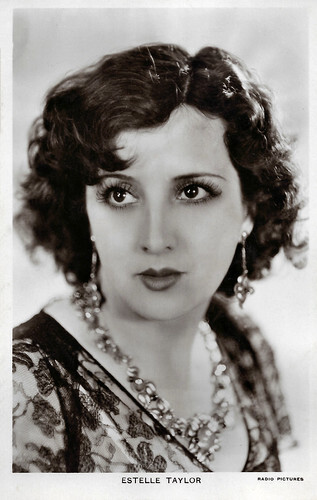
British postcard in the Picturegoer Series, London, no. 219a. Photo: Radio Pictures.
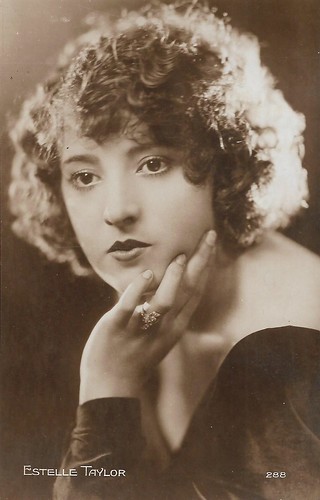
French postcard by Cinémagazine-Edition, Paris, no. 288.
A comedy vamp
Ida Estelle Taylor was born in 1894, in Wilmington, Delaware. Her father was Harry D. Taylor and her mother was Ida LaBertha "Bertha" Barrett. The Taylors had another daughter, Helen, who also became an actress.
In 1911, Estelle married bank cashier Kenneth M. Peacock. The couple remained together for five years until Taylor decided to become an actress. In 1918, Taylor moved to New York City to study acting at the Sargent Dramatic School.
She made her stage debut as a 'comedy vamp' in the play 'Come-On, Charlie', by George V. Hobart. Taylor began looking for work in films. With the help of J. Gordon Edwards, she got a small role in the film A Broadway Saint (Harry O. Hoyt, 1919) starring Montagu Love.
She was hired by the Vitagraph Company for a role with Corinne Griffith in The Tower of Jewels (Tom Terriss, 1920), and also played William Farnum 's leading lady in The Adventurer (J. Gordon Edwards, 1920) for the Fox Film Corporation.
She achieved her first notable success with the crime drama While New York Sleeps (Charles Brabin, 1920) with Marc McDermott. She was a contract player of Fox and William Fox sent her to Fox Film's Hollywood studios. There she played Mercedes opposite John Gilbert as Edmond Dantès in Monte Cristo (Emmett J. Flynn, 1922), based on the novel by Alexandre Dumas .
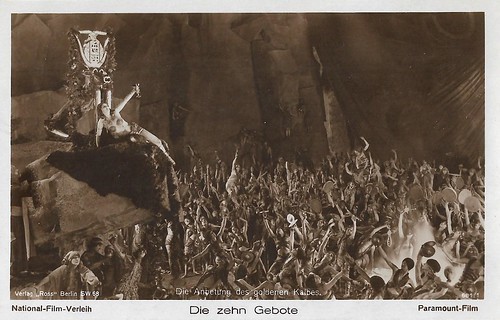
German postcard by Ross Verlag, no. 681/1. Photo: Paramount-Film / National-Verleih. Estelle Taylor as the woman who embraces the Golden Calf, in The Ten Commandments (Cecil B. DeMille, 1923). Caption: The Adoration of the Golden Calf.
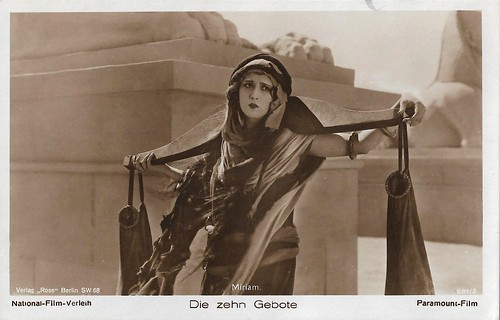
German postcard by Ross Verlag, no. 681/2. Photo: Paramount-Film / National-Verleih. Estelle Taylor as Miriam, sister of Moses in The Ten Commandments (Cecil B. DeMille, 1923). Caption: Miriam.
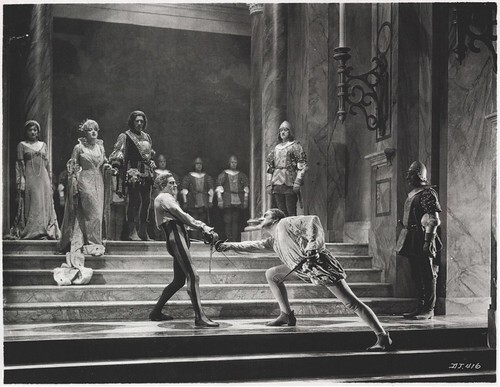
Reproduction of film still for Don Juan (Alan Crossland, 1926). John Barrymore as Don Juan fighting Count Giano Donati (Montague Love), while Cesare Borgia (Warner Oland) and Lucrezia Borgia (Estelle Taylor) look on. Set design by Ben Carré.
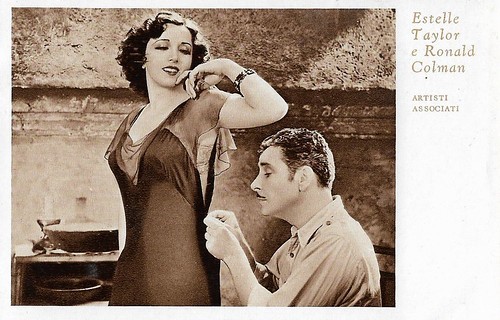
Italian postcard by Cinema-Illustrazione, series 2, no. 24. Photo: United Artists. Estelle Taylor and Ronald Colman in The Unholy Garden (George Fitzmaurice, 1931).
Miriam, the sister of Moses
Estelle Taylor played one of her most memorable roles as Miriam, the sister of Moses (Theodore Roberts), in the biblical prologue of The Ten Commandments (Cecil B. DeMille, 1923), one of the most successful films of the silent era. Her performance in the DeMille film was considered a great acting achievement.
Taylor signed a contract with Paramount Pictures on the strength of her performance as Miriam. She was again praised for her portrayal of Mary, Queen of Scots in Dorothy Vernon of Haddon Hall (Marshall Neilan, 1924) starring Mary Pickford . She became even more famous in 1925 when she married heavyweight champion boxer Jack Dempsey.
The following year, she played Lucrezia Borgia in Don Juan (Alan Crosland, 1926) starring John Barrymore . This was the first feature-length film to use the Vitaphone sound-on-disc sound system with a synchronised musical score and sound effects, though it has no spoken dialogue. Notable sound films in which she appeared include Street Scene (King Vidor, 1931), with Sylvia Sidney , the Academy Award for Best Picture-winning Cimarron (Wesley Ruggles, 1931), with Richard Dix and Irene Dunne , and Call Her Savage (John Francis Dillon, 1932), with Clara Bow .
Although she had made a successful transition to sound films, Taylor retired from film acting in 1932 and decided to focus entirely on her singing career, receiving a salary of $1,000 a week. She performed in Vaudeville, on the stage in musicals, and in nightclubs. At one point, she even gave a concert at New York's Carnegie Hall.
Taylor returned to films with a small part in the Jean Renoir drama The Southerner (1945). It was her last film. Estelle Taylor was also active in animal welfare before her death from cancer in 1958. She was married three times. After her marriage to Jack Dempsey ended in divorce in 1931, she was married to theatrical producer Paul Small (1943-1945).
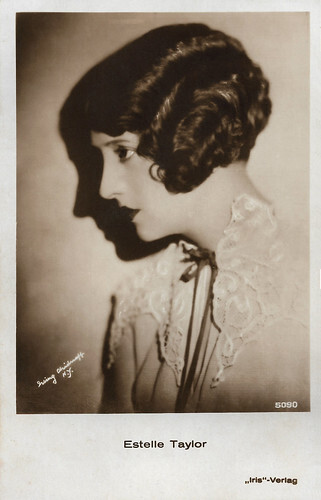
Austrian postcard by Iris Verlag, no. 590. Photo: Irving Chidnoff, N.Y.
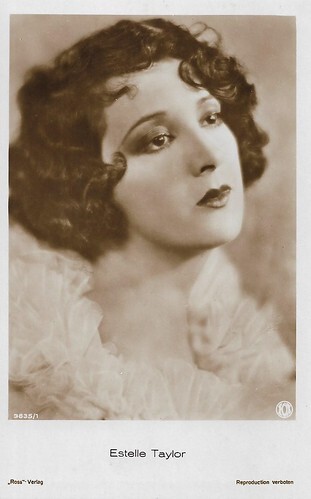
German postcard by Ross Verlag, no. 3835/1, 1928-1929. Photo: Fox.
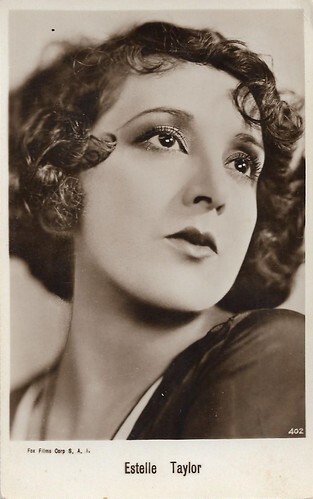
Italian postcard by G.B. Falci, Milano, no. 402. Photo: Fox Films Corp. S.A.I.
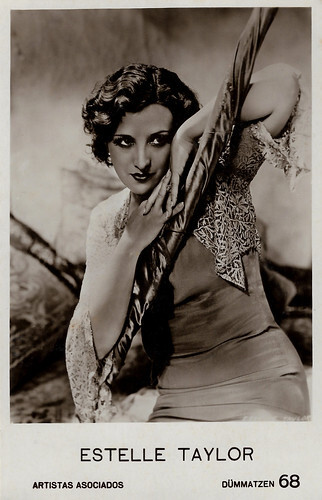
Spanish postcard by Dümmatzen, no. 68. Photo: United Artists.
Sources: Wikipedia and .

British postcard in the Picturegoer Series, London, no. 219.

British postcard in the Picturegoer Series, London, no. 219a. Photo: Radio Pictures.

French postcard by Cinémagazine-Edition, Paris, no. 288.
A comedy vamp
Ida Estelle Taylor was born in 1894, in Wilmington, Delaware. Her father was Harry D. Taylor and her mother was Ida LaBertha "Bertha" Barrett. The Taylors had another daughter, Helen, who also became an actress.
In 1911, Estelle married bank cashier Kenneth M. Peacock. The couple remained together for five years until Taylor decided to become an actress. In 1918, Taylor moved to New York City to study acting at the Sargent Dramatic School.
She made her stage debut as a 'comedy vamp' in the play 'Come-On, Charlie', by George V. Hobart. Taylor began looking for work in films. With the help of J. Gordon Edwards, she got a small role in the film A Broadway Saint (Harry O. Hoyt, 1919) starring Montagu Love.
She was hired by the Vitagraph Company for a role with Corinne Griffith in The Tower of Jewels (Tom Terriss, 1920), and also played William Farnum 's leading lady in The Adventurer (J. Gordon Edwards, 1920) for the Fox Film Corporation.
She achieved her first notable success with the crime drama While New York Sleeps (Charles Brabin, 1920) with Marc McDermott. She was a contract player of Fox and William Fox sent her to Fox Film's Hollywood studios. There she played Mercedes opposite John Gilbert as Edmond Dantès in Monte Cristo (Emmett J. Flynn, 1922), based on the novel by Alexandre Dumas .

German postcard by Ross Verlag, no. 681/1. Photo: Paramount-Film / National-Verleih. Estelle Taylor as the woman who embraces the Golden Calf, in The Ten Commandments (Cecil B. DeMille, 1923). Caption: The Adoration of the Golden Calf.

German postcard by Ross Verlag, no. 681/2. Photo: Paramount-Film / National-Verleih. Estelle Taylor as Miriam, sister of Moses in The Ten Commandments (Cecil B. DeMille, 1923). Caption: Miriam.

Reproduction of film still for Don Juan (Alan Crossland, 1926). John Barrymore as Don Juan fighting Count Giano Donati (Montague Love), while Cesare Borgia (Warner Oland) and Lucrezia Borgia (Estelle Taylor) look on. Set design by Ben Carré.

Italian postcard by Cinema-Illustrazione, series 2, no. 24. Photo: United Artists. Estelle Taylor and Ronald Colman in The Unholy Garden (George Fitzmaurice, 1931).
Miriam, the sister of Moses
Estelle Taylor played one of her most memorable roles as Miriam, the sister of Moses (Theodore Roberts), in the biblical prologue of The Ten Commandments (Cecil B. DeMille, 1923), one of the most successful films of the silent era. Her performance in the DeMille film was considered a great acting achievement.
Taylor signed a contract with Paramount Pictures on the strength of her performance as Miriam. She was again praised for her portrayal of Mary, Queen of Scots in Dorothy Vernon of Haddon Hall (Marshall Neilan, 1924) starring Mary Pickford . She became even more famous in 1925 when she married heavyweight champion boxer Jack Dempsey.
The following year, she played Lucrezia Borgia in Don Juan (Alan Crosland, 1926) starring John Barrymore . This was the first feature-length film to use the Vitaphone sound-on-disc sound system with a synchronised musical score and sound effects, though it has no spoken dialogue. Notable sound films in which she appeared include Street Scene (King Vidor, 1931), with Sylvia Sidney , the Academy Award for Best Picture-winning Cimarron (Wesley Ruggles, 1931), with Richard Dix and Irene Dunne , and Call Her Savage (John Francis Dillon, 1932), with Clara Bow .
Although she had made a successful transition to sound films, Taylor retired from film acting in 1932 and decided to focus entirely on her singing career, receiving a salary of $1,000 a week. She performed in Vaudeville, on the stage in musicals, and in nightclubs. At one point, she even gave a concert at New York's Carnegie Hall.
Taylor returned to films with a small part in the Jean Renoir drama The Southerner (1945). It was her last film. Estelle Taylor was also active in animal welfare before her death from cancer in 1958. She was married three times. After her marriage to Jack Dempsey ended in divorce in 1931, she was married to theatrical producer Paul Small (1943-1945).

Austrian postcard by Iris Verlag, no. 590. Photo: Irving Chidnoff, N.Y.

German postcard by Ross Verlag, no. 3835/1, 1928-1929. Photo: Fox.

Italian postcard by G.B. Falci, Milano, no. 402. Photo: Fox Films Corp. S.A.I.

Spanish postcard by Dümmatzen, no. 68. Photo: United Artists.
Sources: Wikipedia and .
Published on September 19, 2024 22:00
September 18, 2024
La sfinge (1918)
Italian diva Maria Jacobini starred as a femme fatale in the Italian silent film La sfinge/The Sphinx (Mario Caserini, 1918), produced by Tiber Film. What happens when she meets a homme fatale, played by André Habay? In Spain, a series of cromos for film fans was published to promote the film.
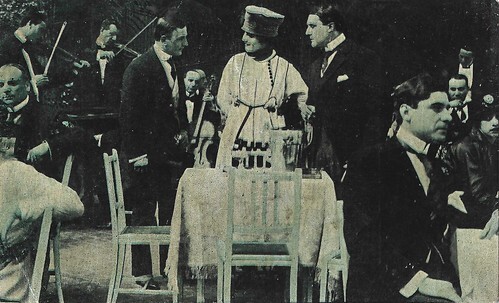
Spanish cromo for Chocolat Imperiale, Card 1 of 6. Photo: J. Verdaguer, Barcelona / Tiber Film. Maria Jacobini (middle), André Habay (right), and Alberto Collo (left) in La sfinge/The Sphinx (Mario Caserini, 1918).
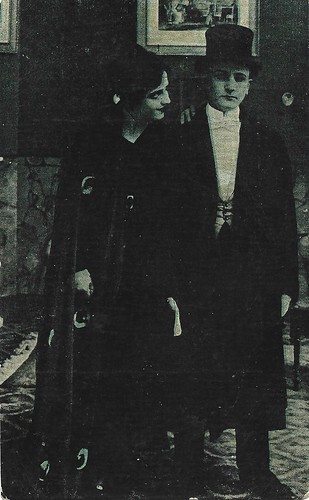
Spanish cromo for Chocolat Imperiale, Card 2 of 6. Photo: J. Verdaguer, Barcelona / Tiber Film. Maria Jacobini and Alberto Collo in La sfinge/The Sphinx (Mario Caserini, 1918).
A likewise unrequited passion
The writer Adriana Simon (Maria Jacobini) is nicknamed 'The Sphinx'. She plays with the passions of men just to inspire her to new artistic creations.
When Poligny ( Alberto Collo ) ruins himself for her, she doesn't care less.
But using the same arms as Adriana, the sceptic and indifferent Luciano ( André Habay ) arouses with Adriana a likewise unrequited passion.
When Poligny understands he will never obtain her love, he pushes Adriana into the arms of Luciano.
Only at the very last moment, he revises...
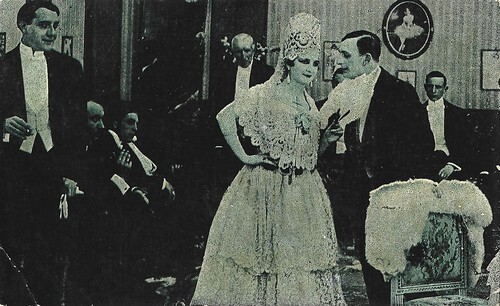
Spanish cromo for Chocolat Imperiale, Card 3 of 6. Photo: J. Verdaguer, Barcelona / Tiber Film. André Habay (left) and Alberto Collo (right) in La sfinge/The Sphinx (Mario Caserini, 1918). The actress in the middle does not seem to be Maria Jacobini .
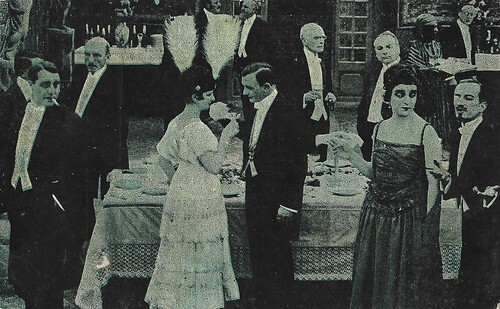
Spanish cromo for Chocolat Imperiale, Card 4 of 6. Photo: J. Verdaguer, Barcelona / Tiber Film. Maria Jacobini (right), André Habay (middle), and Alberto Collo (left) in La sfinge/The Sphinx (Mario Caserini, 1918).
A pleasant, simple and entertaining film comedy with a warning
From 1916 on Maria Jacobini worked for Tiber Film. There she made four films with director Mario Caserini: the Lev Tolstoy adaptation Resurrezione/Resurrection (1917), Il filo della vita/The Thread of Life (1918), La signora Arlecchino/Mrs Harlequin (1918) and La sfinge/The Sphinx (1918).
La sfinge/The Sphinx (Mario Caserini, 1918) was scripted by Pio Vanzi and cinematographed by Antonio Cufaro.
The film had its Roman premiere on 1 January 1918 and thus was filmed in 1917.
In the Turinese film journal La vita cinematografica, the critic Bertoldo remarked that, although a pleasant, simple and entertaining film comedy, La sfinge/The Sphinx still warns against the useless presumption of the denial of the human instinct.
The only flaw was its length and some useless scenes. Both the actors' performances of Jacobini, Collo and Habay and the mise-en-scene by Caserini were praised, as well as the cinematography by Antonio Cufaro.
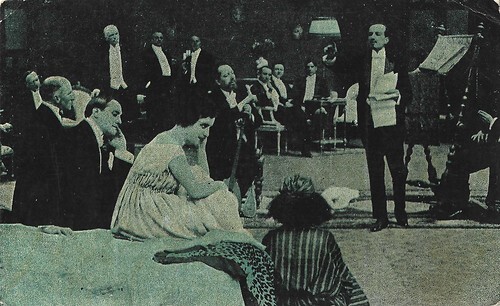
Spanish cromo for Chocolat Imperiale, Card 5 of 6. Photo: J. Verdaguer, Barcelona / Tiber Film. Maria Jacobini and André Habay (left of her) in La sfinge/The Sphinx (Mario Caserini, 1918).
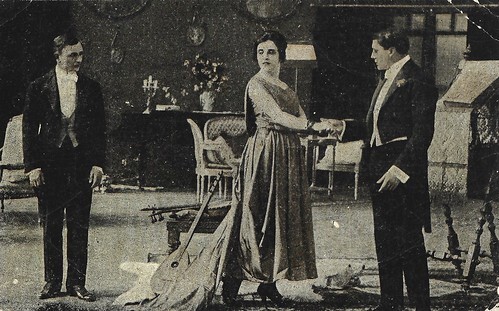
Spanish cromo for Chocolat Imperiale, Card 6 of 6. Photo: J. Verdaguer, Barcelona / Tiber Film. Maria Jacobini , Alberto Collo (left) and André Habay (right) in La sfinge/The Sphinx (Mario Caserini, 1918).
Sources: the Cromos, Treccani (Italian), Wikipedia (Italian) and IMDb.

Spanish cromo for Chocolat Imperiale, Card 1 of 6. Photo: J. Verdaguer, Barcelona / Tiber Film. Maria Jacobini (middle), André Habay (right), and Alberto Collo (left) in La sfinge/The Sphinx (Mario Caserini, 1918).

Spanish cromo for Chocolat Imperiale, Card 2 of 6. Photo: J. Verdaguer, Barcelona / Tiber Film. Maria Jacobini and Alberto Collo in La sfinge/The Sphinx (Mario Caserini, 1918).
A likewise unrequited passion
The writer Adriana Simon (Maria Jacobini) is nicknamed 'The Sphinx'. She plays with the passions of men just to inspire her to new artistic creations.
When Poligny ( Alberto Collo ) ruins himself for her, she doesn't care less.
But using the same arms as Adriana, the sceptic and indifferent Luciano ( André Habay ) arouses with Adriana a likewise unrequited passion.
When Poligny understands he will never obtain her love, he pushes Adriana into the arms of Luciano.
Only at the very last moment, he revises...

Spanish cromo for Chocolat Imperiale, Card 3 of 6. Photo: J. Verdaguer, Barcelona / Tiber Film. André Habay (left) and Alberto Collo (right) in La sfinge/The Sphinx (Mario Caserini, 1918). The actress in the middle does not seem to be Maria Jacobini .

Spanish cromo for Chocolat Imperiale, Card 4 of 6. Photo: J. Verdaguer, Barcelona / Tiber Film. Maria Jacobini (right), André Habay (middle), and Alberto Collo (left) in La sfinge/The Sphinx (Mario Caserini, 1918).
A pleasant, simple and entertaining film comedy with a warning
From 1916 on Maria Jacobini worked for Tiber Film. There she made four films with director Mario Caserini: the Lev Tolstoy adaptation Resurrezione/Resurrection (1917), Il filo della vita/The Thread of Life (1918), La signora Arlecchino/Mrs Harlequin (1918) and La sfinge/The Sphinx (1918).
La sfinge/The Sphinx (Mario Caserini, 1918) was scripted by Pio Vanzi and cinematographed by Antonio Cufaro.
The film had its Roman premiere on 1 January 1918 and thus was filmed in 1917.
In the Turinese film journal La vita cinematografica, the critic Bertoldo remarked that, although a pleasant, simple and entertaining film comedy, La sfinge/The Sphinx still warns against the useless presumption of the denial of the human instinct.
The only flaw was its length and some useless scenes. Both the actors' performances of Jacobini, Collo and Habay and the mise-en-scene by Caserini were praised, as well as the cinematography by Antonio Cufaro.

Spanish cromo for Chocolat Imperiale, Card 5 of 6. Photo: J. Verdaguer, Barcelona / Tiber Film. Maria Jacobini and André Habay (left of her) in La sfinge/The Sphinx (Mario Caserini, 1918).

Spanish cromo for Chocolat Imperiale, Card 6 of 6. Photo: J. Verdaguer, Barcelona / Tiber Film. Maria Jacobini , Alberto Collo (left) and André Habay (right) in La sfinge/The Sphinx (Mario Caserini, 1918).
Sources: the Cromos, Treccani (Italian), Wikipedia (Italian) and IMDb.
Published on September 18, 2024 22:00
September 17, 2024
Ross Verlag, Part 3: The Last Years of Weimar
EFSP brings a tribute to Ross Verlag in weekly parts. The German publishing company produced thousands of star postcards from the late 1910s till the early 1940s. For the third part of this series, we chose 25 postcards of German stars of the early 1930s. Many of these stars of the Weimar cinema had to flee the country when the Nazis started their reign of terror in 1933.
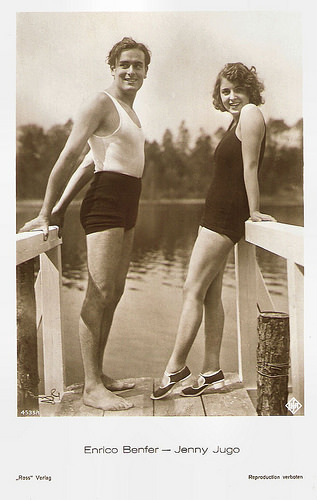
German postcard by Ross Verlag, no. 4535/1, 1929-1930. Photo: Ufa. Enrico Benfer and Jenny Jugo .
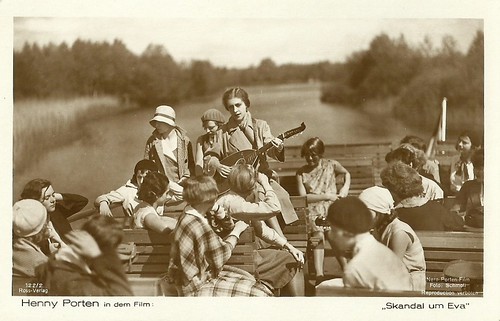
German postcard by Ross Verlag, no. 122/2. Photo: Schmoll / Nero-Porten-Film. Henny Porten in Skandal um Eva/Scandalous Eva (Georg Wilhelm Pabst, 1930).
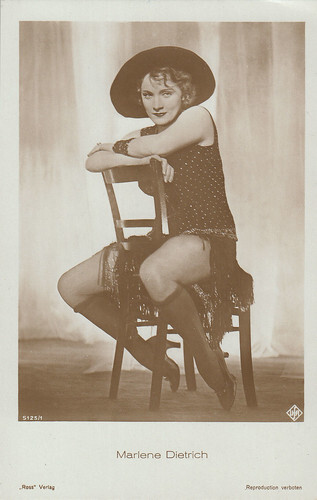
German postcard by Ross Verlag, no. 5125/1, 1930-1931. Photo: Ufa. Marlene Dietrich in Der blaue Engel/The Blue Angel (Josef von Sternberg, 1930). Collection: Marlene Pilaete.
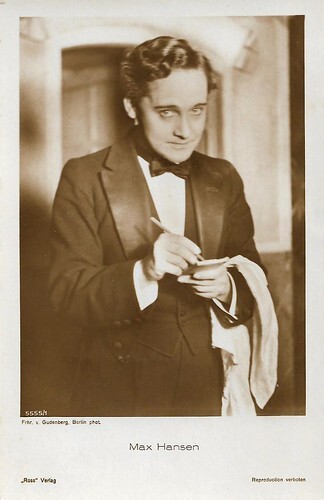
German postcard by Ross Verlag, no. 5555/1, 1930-1931. Photo: Freiherr von Gudenberg, Berlin. Max Hansen .
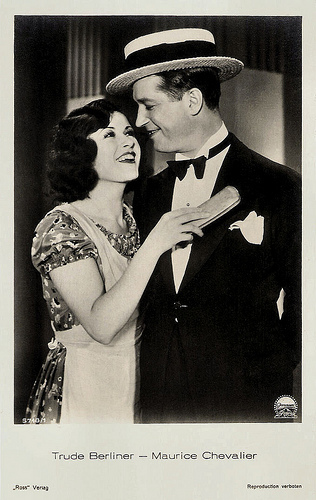
German postcard by Ross Verlag, no. 5748/1, 1930-1931. Photo: Paramount. Trude Berliner and Maurice Chevalier . It is unknown for which film this still was made. Probably it was an alternative language version of a Paramount production, produced at the studios in Saint-Maurice, a commune in the southeastern suburbs of Paris.
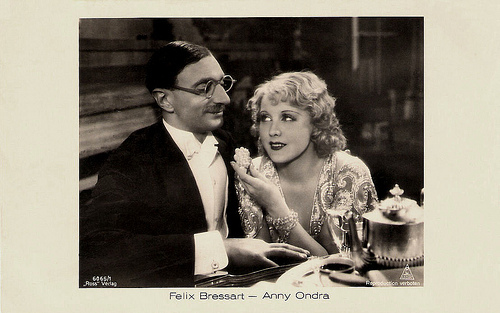
German postcard by Ross Verlag, no. 6065/1, 1931-1932. Photo: Ondra Lamac Film. Publicity still for Eine Freundin so goldig wie Du/A Cute Girlfriend Like You (Carl Lamac, 1930) with Felix Bressart and Anny Ondra .
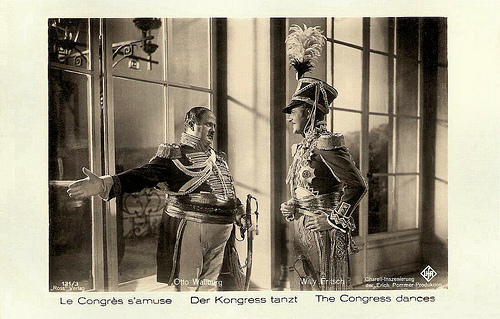
German postcard by Ross Verlag, no. 131/3. Photo: Ufa. Still from Der Kongress tanzt/The Congress Dances (1931) with Otto Wallburg and Willy Fritsch .
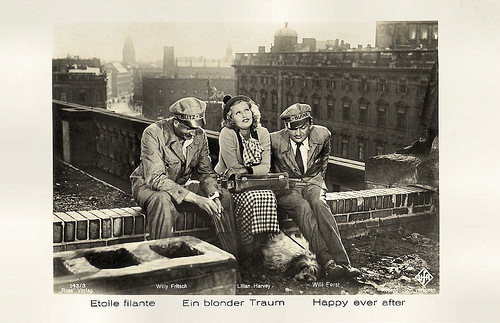
German postcard by Ross Verlag, no. 143/3, 1931-1932. Photo: Ufa. Publicity still for Ein blonder Traum/Happy Ever After (Paul Martin, 1932) with Willy Fritsch , Lilian Harvey and Willi Forst .
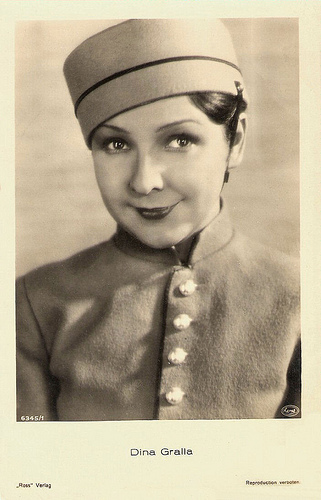
German postcard by Ross Verlag, no. 6345/1, 1931-1932. Photo: Heros. Dina Gralla .
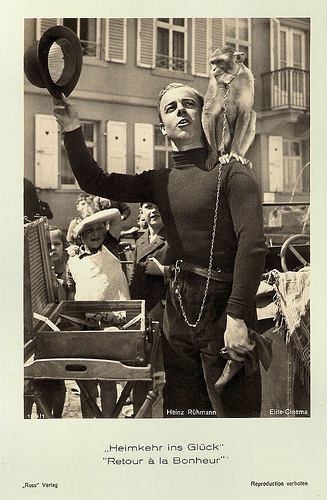
German postcard by Ross-Verlag, no. 189/1. Photo: Elite-Cinema. Publicity still for Heimkehr ins Glück/Return to Happiness (Carl Boese, 1933) with Heinz Rühmann .
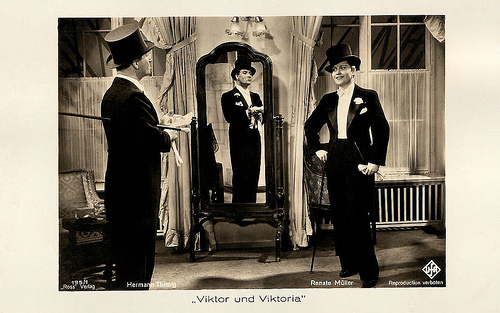
German postcard by Ross Verlag, no. 195/1. Photo: Ufa. Publicity still for Viktor und Viktoria/Viktor and Viktoria (Reinhold Schünzel, 1933) with Renate Müller and Hermann Thimig .
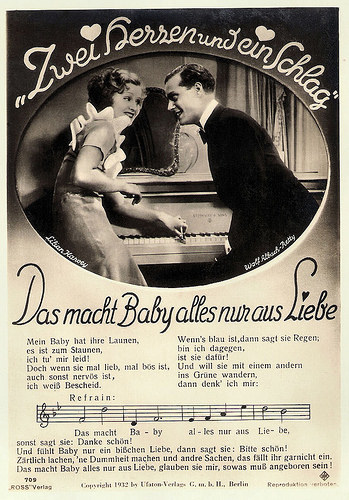
German postcard by Ross Verlag, no. 709. Photo: Ufa. Publicity still for Zwei Herzen und ein Schlag/Two Hearts Beat as One (Wilhelm Thiele, 1932) with Lilian Harvey and Wolf Albach-Retty . Collection: Geoffrey Donaldson Institute.
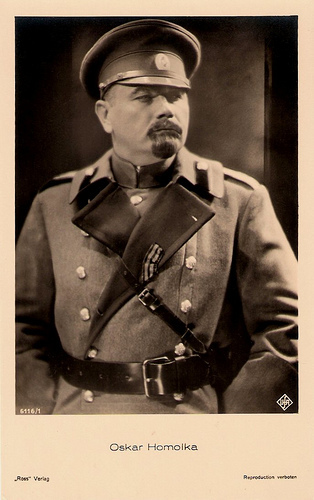
German postcard by Ross Verlag, no. 6116/1, 1931-1932. Photo: Ufa. Oskar Homolka in Im Geheimdienst/In the Employ of the Secret Service (Gustav Ucicky, 1931).
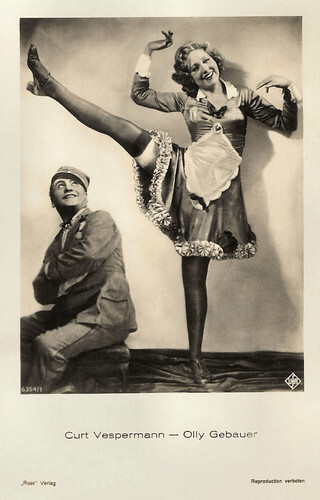
German postcard by Ross Verlag, no. 6354/1, 1931-1932. Photo: Ufa. Olly Gebauer and Kurt (Curt) Vespermann in the musical comedy Ronny (Reinhold Schünzel, 1931).
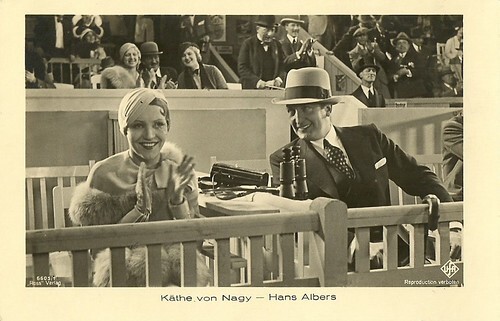
German postcard by Ross Verlag, no. 6605/1, 1931-1932. Photo: Ufa. Käthe von Nagy and Hans Albers in Der Sieger/The Winner (Paul Martin and Hans Hinrich, 1932).
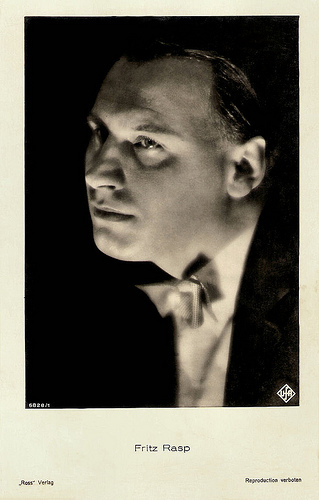
German postcard by Ross Verlag, no. 6828/1, 1931-1932. Photo: Ufa. Fritz Rasp .
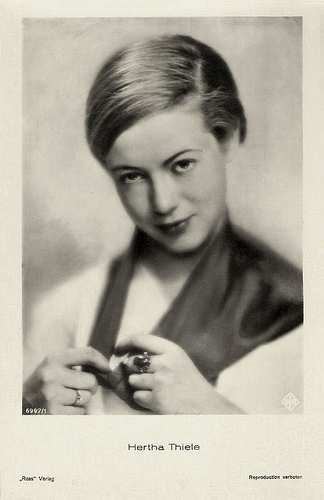
German postcard by Ross Verlag, no. 6997/1, 1931-1932. Photo: Ufa. Hertha Thiele .
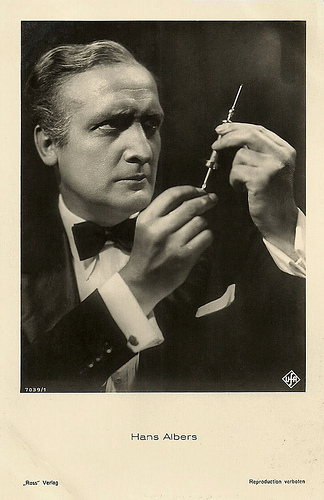
German postcard. by Ross Verlag, no. 7039/1, 1932-1933. Photo: Ufa. Publicity still for Der weiße Dämon/Dope (Kurt Gerron, 1932) with Hans Albers .
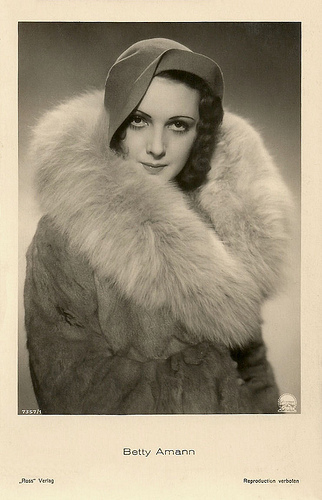
German postcard by Ross Verlag, no. 7357/1, 1932-1933. Photo: Paramount. Betty Amann .
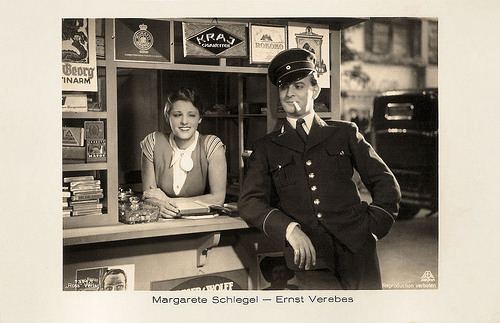
German postcard by Ross Verlag, no. 7394/1, 1932-1933. Photo: Aafa Film. Publicity still for Das blaue vom Himmel/The Blue from the Sky (Victor Janson, 1932) with Margarete Schlegel and Ernst Verebes.
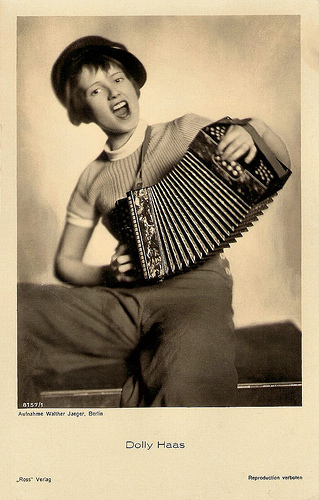
German postcard by Ross Verlag, no. 8157/1, 1933-1934. Photo: Walther Jaeger, Berlin. Dolly Haas in Scampolo, ein Kind der Straße/A Girl of the Street (Hans Steinhoff, 1932).
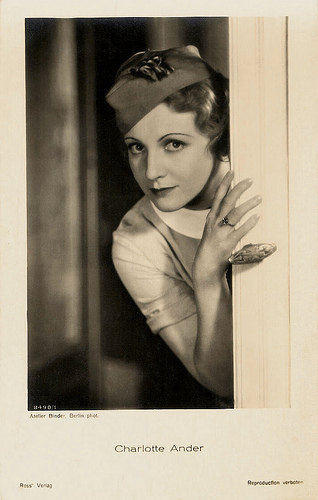
German postcard by Ross Verlag, no. 8490/1, 1933-1934. Photo: Atelier Binder, Berlin. Charlotte Ander .
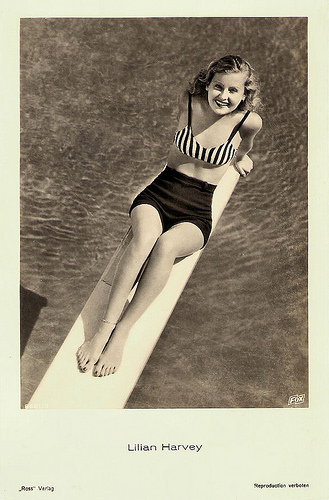
German postcard by Ross Verlag, no. 8581/3, 1933-1934. Photo: Fox (20th Century Fox). Lilian Harvey in Hollywood.
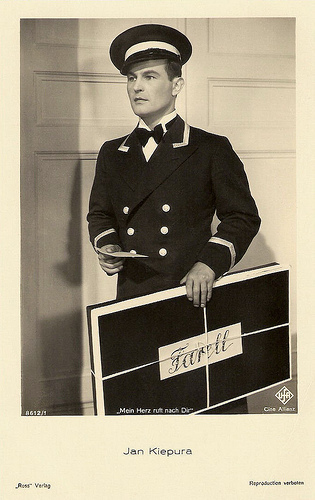
German postcard by Ross Verlag, no. 8612/1, 1933-1934. Photo: Ufa / Cine-Allianz. Still from Mein Herz Ruft nach Dir/My Heart Calls You (Carmine Gallone, 1934) with Jan Kiepura .
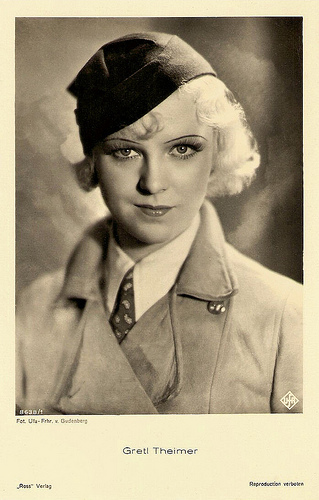
German postcard by Ross Verlag, no. 8638/1, 1933-1934. Photo: Frhr. von Gudenberg / Ufa. Gretl Theimer.
The Ross Verlag Tribute is to be continued. This post was last updated on 7 August 2024.

German postcard by Ross Verlag, no. 4535/1, 1929-1930. Photo: Ufa. Enrico Benfer and Jenny Jugo .

German postcard by Ross Verlag, no. 122/2. Photo: Schmoll / Nero-Porten-Film. Henny Porten in Skandal um Eva/Scandalous Eva (Georg Wilhelm Pabst, 1930).

German postcard by Ross Verlag, no. 5125/1, 1930-1931. Photo: Ufa. Marlene Dietrich in Der blaue Engel/The Blue Angel (Josef von Sternberg, 1930). Collection: Marlene Pilaete.

German postcard by Ross Verlag, no. 5555/1, 1930-1931. Photo: Freiherr von Gudenberg, Berlin. Max Hansen .

German postcard by Ross Verlag, no. 5748/1, 1930-1931. Photo: Paramount. Trude Berliner and Maurice Chevalier . It is unknown for which film this still was made. Probably it was an alternative language version of a Paramount production, produced at the studios in Saint-Maurice, a commune in the southeastern suburbs of Paris.

German postcard by Ross Verlag, no. 6065/1, 1931-1932. Photo: Ondra Lamac Film. Publicity still for Eine Freundin so goldig wie Du/A Cute Girlfriend Like You (Carl Lamac, 1930) with Felix Bressart and Anny Ondra .

German postcard by Ross Verlag, no. 131/3. Photo: Ufa. Still from Der Kongress tanzt/The Congress Dances (1931) with Otto Wallburg and Willy Fritsch .

German postcard by Ross Verlag, no. 143/3, 1931-1932. Photo: Ufa. Publicity still for Ein blonder Traum/Happy Ever After (Paul Martin, 1932) with Willy Fritsch , Lilian Harvey and Willi Forst .

German postcard by Ross Verlag, no. 6345/1, 1931-1932. Photo: Heros. Dina Gralla .

German postcard by Ross-Verlag, no. 189/1. Photo: Elite-Cinema. Publicity still for Heimkehr ins Glück/Return to Happiness (Carl Boese, 1933) with Heinz Rühmann .

German postcard by Ross Verlag, no. 195/1. Photo: Ufa. Publicity still for Viktor und Viktoria/Viktor and Viktoria (Reinhold Schünzel, 1933) with Renate Müller and Hermann Thimig .

German postcard by Ross Verlag, no. 709. Photo: Ufa. Publicity still for Zwei Herzen und ein Schlag/Two Hearts Beat as One (Wilhelm Thiele, 1932) with Lilian Harvey and Wolf Albach-Retty . Collection: Geoffrey Donaldson Institute.

German postcard by Ross Verlag, no. 6116/1, 1931-1932. Photo: Ufa. Oskar Homolka in Im Geheimdienst/In the Employ of the Secret Service (Gustav Ucicky, 1931).

German postcard by Ross Verlag, no. 6354/1, 1931-1932. Photo: Ufa. Olly Gebauer and Kurt (Curt) Vespermann in the musical comedy Ronny (Reinhold Schünzel, 1931).

German postcard by Ross Verlag, no. 6605/1, 1931-1932. Photo: Ufa. Käthe von Nagy and Hans Albers in Der Sieger/The Winner (Paul Martin and Hans Hinrich, 1932).

German postcard by Ross Verlag, no. 6828/1, 1931-1932. Photo: Ufa. Fritz Rasp .

German postcard by Ross Verlag, no. 6997/1, 1931-1932. Photo: Ufa. Hertha Thiele .

German postcard. by Ross Verlag, no. 7039/1, 1932-1933. Photo: Ufa. Publicity still for Der weiße Dämon/Dope (Kurt Gerron, 1932) with Hans Albers .

German postcard by Ross Verlag, no. 7357/1, 1932-1933. Photo: Paramount. Betty Amann .

German postcard by Ross Verlag, no. 7394/1, 1932-1933. Photo: Aafa Film. Publicity still for Das blaue vom Himmel/The Blue from the Sky (Victor Janson, 1932) with Margarete Schlegel and Ernst Verebes.

German postcard by Ross Verlag, no. 8157/1, 1933-1934. Photo: Walther Jaeger, Berlin. Dolly Haas in Scampolo, ein Kind der Straße/A Girl of the Street (Hans Steinhoff, 1932).

German postcard by Ross Verlag, no. 8490/1, 1933-1934. Photo: Atelier Binder, Berlin. Charlotte Ander .

German postcard by Ross Verlag, no. 8581/3, 1933-1934. Photo: Fox (20th Century Fox). Lilian Harvey in Hollywood.

German postcard by Ross Verlag, no. 8612/1, 1933-1934. Photo: Ufa / Cine-Allianz. Still from Mein Herz Ruft nach Dir/My Heart Calls You (Carmine Gallone, 1934) with Jan Kiepura .

German postcard by Ross Verlag, no. 8638/1, 1933-1934. Photo: Frhr. von Gudenberg / Ufa. Gretl Theimer.
The Ross Verlag Tribute is to be continued. This post was last updated on 7 August 2024.
Published on September 17, 2024 22:00
September 16, 2024
Hermann Speelmans
German stage and film actor Hermann Speelmans (1902-1960) was a popular Ufa supporting actor of the 1930s and 1940s. He often played 'nice chaps' or friends of the hero in such films as Der Mann, der seinen Mörder sucht (1931), Danton (1931), and Ein gewisser Herr Gran (1933).
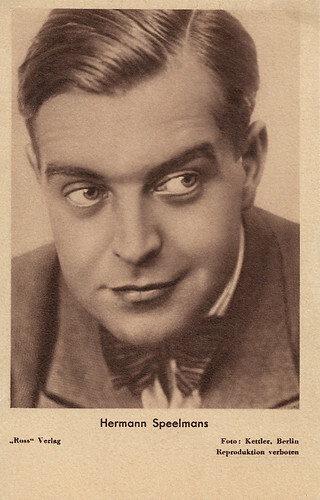
German postcard for Das Programma von Heute by Ross Verlag. Photo: Ketttler, Berlin.
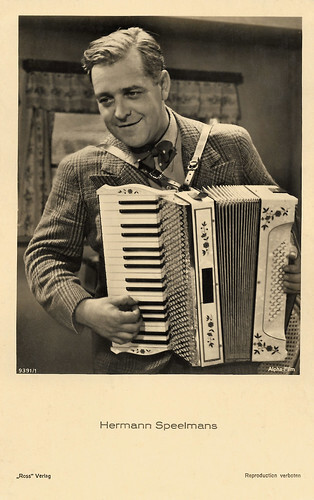
German postcard by Ross Verlag, no. 9391/1, 1935-1936. Photo: Alpha-Film. Hermann Speelmans in Verlieb Dich nicht am Bodensee/Don't Fall in Love at Lake Constance (Carl Heinz Wolff, 1935).
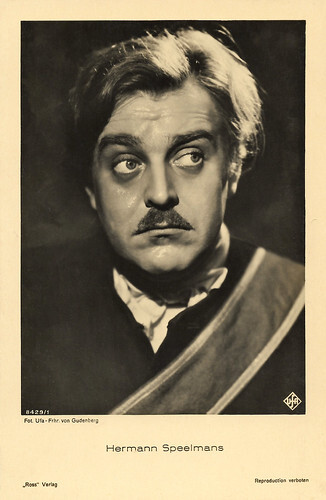
German postcard by Ross Verlag, no. 8429/1, 1933-1934. Photo: Ufa / Frhr. von Gudenberg.
A ‘whole guy’ and a good mate
Hermann Speelmans was born Hermann Maria Louise Speelmans in 1902 in Uerdingen, Krefeld, Germany. (Some sources say in 1906). He studied philosophy, art history and sociology in Cologne, Heidelberg and Berlin. During his doctoral thesis on European nihilism, he first came to the theatre as an extra in Cologne.
After graduating, he began his acting career in 1924 at the Schauspielhaus Köln (Cologne Theatre). In 1925 he played in Hagen and in 1926 at the Deutsches Theater in Berlin. He was thought to have disappeared after a voyage. Heinz Hilpert had him searched for, and when Speelmans reappeared in Marseille, he engaged him at the Renaissance Theatre in 1928. In 1930-1931 he worked at the Tribüne, later also at the Komödie.
He made his film debut in 1929 and played small roles in the comedy Ihr dunkler Punkt/Her Dark Secret (Johannes Guter, 1929) starring Lilian Harvey and Willy Fritsch , Diane - Die Geschichte einer Pariserin/Diane - The Story of a Parisian Woman (Erich Waschneck, 1929) with Olga Tschechowa, and the historical drama Danton (Hans Behrendt, 1931) starring Fritz Kortner .
Speelmans was given his first bigger film role in the comedy Der Mann, der seinen Mörder sucht/The Man Who Wanted His Murderer (Robert Siodmak, 1931) co-written by Billy Wilder and starring the upcoming Heinz Rühmann and Lien Deyers . It was followed by roles in other popular films like the comedy Der Hauptmann von Köpenick/The Captain from Köpenick (Richard Oswald, 1931), the Sci-Fi adventure F.P. 1 antwortet nicht/F.P.1 Doesn't Answer (Karl Hartl, 1932) starring Hans Albers , the comedy Strich durch die Rechnung/Spoiling the Game (Alfred Zeisler, 1932), and the action film Ein gewisser Herr Gran/A Certain Mr Gran (Gerhard Lamprecht, 1933).
During the German Reich from 1933 to 1945, he was frequently used in Ufa productions as a ‘whole guy’ and good mate in such Propaganda films as Hitlerjunge Quex/Our Flag Leads Us Forward (Hans Steinhoff, 1933), Ein Mann will nach Deutschland/A German Wants to Go Home (Paul Wegener, 1934) and Alarm auf Station III/Alarm at Station III (Philipp Lothar Mayring, 1939). Sometimes he played a crook, but often he was a friend of the actual hero. Physically, he was a rather unlikely actor to portray Sherlock Holmes on screen. However, in Sherlock Holmes (Erich Engels, 1937) with Trude Marlen , Speelmans appeared as the famous British sleuth, masquerading as Jimmy Ward, a dapper young socialite, working with the secret police to infiltrate a criminal organisation.
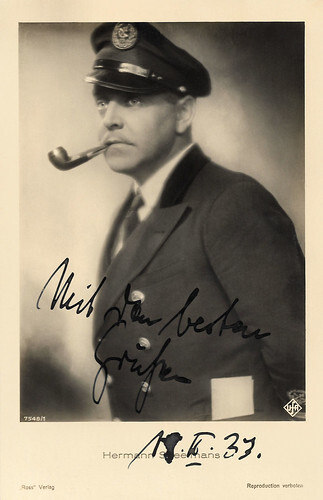
German postcard by Ross Verlag, no. 7548/1, 1932-1933. Photo: Ufa. Autographed in 1933.
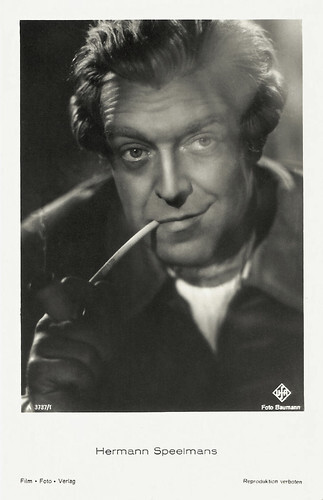
German postcard by Film-Foto-Verlag, Berlin, no. A 3737/1, 1941-1944. Photo: Baumann / Ufa.
The God-gifted list
Hermann Speelmans continued his career during the Second World War with films like the romantic drama Auf Wiedersehen, Franziska!/Goodbye, Franziska! (Helmut Käutner, 1941) starring Marianne Hoppe , and Meine vier Jungens/My Four Boys (Günther Rittau, 1944) with Käthe Haack . He also appeared as Christian Kuchenreutter in the lavish mega-production Münchhausen/The Adventures of Baron Munchausen (Josef von Báky, 1943) starring Hans Albers . Nazi Propaganda Minister Joseph Goebbels ordered the production of Münchhausen to celebrate the 25th anniversary of the Ufa film studio which released it.
Münchhausen represented the pinnacle of the Volksfilm style of propaganda designed to entertain the masses and distract the population from the war, borrowing the Hollywood genre of large-budget productions with extensive colourful visuals. The film provided visual relief from the war and, as one of the few fantastical films produced by the Ministry of Propaganda, represented a rare opportunity for escapism. Both during and after World War II, the film saw massive commercial and critical success.
In 1944, Speelmans was on the 'Gottbegnadeten-Liste' (God-gifted list), a 36-page list of artists considered crucial to National Socialist culture. The list was assembled in September 1944 by Joseph Goebbels, the head of the Ministry of Public Enlightenment and Propaganda, and Germany's supreme leader Adolf Hitler. The list exempted the designated artists from military mobilisation during the final stages of World War II.
At the end of the war in 1945, Speelmans founded his own travelling theatre company ‘Werkstatt’ and toured the provinces with it for three years. During this time, he appeared in the anthology film In jenen Tagen/In Those Days (Helmut Käutner, 1947). During the 1950s, he appeared in films such as Gift im Zoo/Poison in the Zoo (Hans Müller, Wolfgang Staudte, 1952) starring Irene von Meyendorff , the crime film Banditen der Autobahn/Bandits of the Highway (Géza von Cziffra, 1955) and the drama Hanussen (O.W. Fischer, Georg Marischka, 1955) starring O.W. Fischer as the mind-reader who reportedly taught Hitler his crowd control techniques of using gestures and dramatic pauses.
Speelmans suffered from alcohol problems and his engagements dropped off. His final film was the comedy Liebe, Luft und lauter Lügen/Love, Air and Lies (Peter Beauvais, 1959). Speelmans became the German synchronising voice for Herbert Lom and Akim Tamiroff. In 1960, Speelmans collapsed on a Berlin street from a heart attack and died shortly afterwards. He had just signed a contract with the East German film company Defa. Hermann Speelmans was 57. He was buried in the Waldfriedhof Zehlendorf (Zehlendorf forest cemetery), but his grave has since been closed.
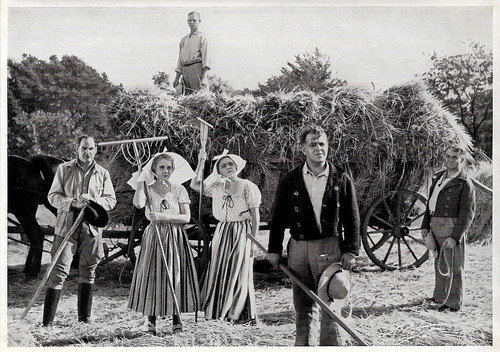
German collector card in the series 'Vom Werden deutscher Filmkunst - Der Tonfilm', album no. 11, picture no. 105. Photo: Ufa / Ross Verlag. Hans Adalbert Schlettow , Cilly Feindt and Hermann Speelmans in Ferien von Ich/Vacation from me (Hans Deppe, 1934).
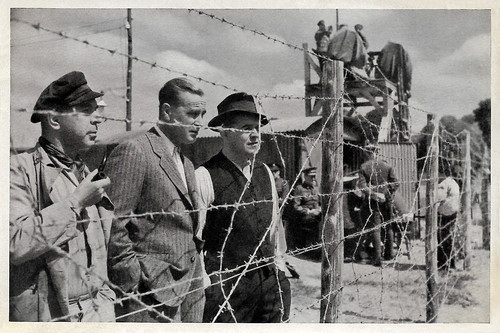
German collector card in the series 'Vom Werden deutscher Filmkunst - Der Tonfilm', album no. 11, picture no. 107. Photo: Ufa / Ross Verlag. Willi Schur, Karl Ludwig Diehl and Hermann Speelmans in Ein Mann will nach Deutschland/A Man Wants to Get to Germany (Paul Wegener, 1934).
Sources: Thomas Staedeli (Cyranos), Wikipedia (English and German) and .

German postcard for Das Programma von Heute by Ross Verlag. Photo: Ketttler, Berlin.

German postcard by Ross Verlag, no. 9391/1, 1935-1936. Photo: Alpha-Film. Hermann Speelmans in Verlieb Dich nicht am Bodensee/Don't Fall in Love at Lake Constance (Carl Heinz Wolff, 1935).

German postcard by Ross Verlag, no. 8429/1, 1933-1934. Photo: Ufa / Frhr. von Gudenberg.
A ‘whole guy’ and a good mate
Hermann Speelmans was born Hermann Maria Louise Speelmans in 1902 in Uerdingen, Krefeld, Germany. (Some sources say in 1906). He studied philosophy, art history and sociology in Cologne, Heidelberg and Berlin. During his doctoral thesis on European nihilism, he first came to the theatre as an extra in Cologne.
After graduating, he began his acting career in 1924 at the Schauspielhaus Köln (Cologne Theatre). In 1925 he played in Hagen and in 1926 at the Deutsches Theater in Berlin. He was thought to have disappeared after a voyage. Heinz Hilpert had him searched for, and when Speelmans reappeared in Marseille, he engaged him at the Renaissance Theatre in 1928. In 1930-1931 he worked at the Tribüne, later also at the Komödie.
He made his film debut in 1929 and played small roles in the comedy Ihr dunkler Punkt/Her Dark Secret (Johannes Guter, 1929) starring Lilian Harvey and Willy Fritsch , Diane - Die Geschichte einer Pariserin/Diane - The Story of a Parisian Woman (Erich Waschneck, 1929) with Olga Tschechowa, and the historical drama Danton (Hans Behrendt, 1931) starring Fritz Kortner .
Speelmans was given his first bigger film role in the comedy Der Mann, der seinen Mörder sucht/The Man Who Wanted His Murderer (Robert Siodmak, 1931) co-written by Billy Wilder and starring the upcoming Heinz Rühmann and Lien Deyers . It was followed by roles in other popular films like the comedy Der Hauptmann von Köpenick/The Captain from Köpenick (Richard Oswald, 1931), the Sci-Fi adventure F.P. 1 antwortet nicht/F.P.1 Doesn't Answer (Karl Hartl, 1932) starring Hans Albers , the comedy Strich durch die Rechnung/Spoiling the Game (Alfred Zeisler, 1932), and the action film Ein gewisser Herr Gran/A Certain Mr Gran (Gerhard Lamprecht, 1933).
During the German Reich from 1933 to 1945, he was frequently used in Ufa productions as a ‘whole guy’ and good mate in such Propaganda films as Hitlerjunge Quex/Our Flag Leads Us Forward (Hans Steinhoff, 1933), Ein Mann will nach Deutschland/A German Wants to Go Home (Paul Wegener, 1934) and Alarm auf Station III/Alarm at Station III (Philipp Lothar Mayring, 1939). Sometimes he played a crook, but often he was a friend of the actual hero. Physically, he was a rather unlikely actor to portray Sherlock Holmes on screen. However, in Sherlock Holmes (Erich Engels, 1937) with Trude Marlen , Speelmans appeared as the famous British sleuth, masquerading as Jimmy Ward, a dapper young socialite, working with the secret police to infiltrate a criminal organisation.

German postcard by Ross Verlag, no. 7548/1, 1932-1933. Photo: Ufa. Autographed in 1933.

German postcard by Film-Foto-Verlag, Berlin, no. A 3737/1, 1941-1944. Photo: Baumann / Ufa.
The God-gifted list
Hermann Speelmans continued his career during the Second World War with films like the romantic drama Auf Wiedersehen, Franziska!/Goodbye, Franziska! (Helmut Käutner, 1941) starring Marianne Hoppe , and Meine vier Jungens/My Four Boys (Günther Rittau, 1944) with Käthe Haack . He also appeared as Christian Kuchenreutter in the lavish mega-production Münchhausen/The Adventures of Baron Munchausen (Josef von Báky, 1943) starring Hans Albers . Nazi Propaganda Minister Joseph Goebbels ordered the production of Münchhausen to celebrate the 25th anniversary of the Ufa film studio which released it.
Münchhausen represented the pinnacle of the Volksfilm style of propaganda designed to entertain the masses and distract the population from the war, borrowing the Hollywood genre of large-budget productions with extensive colourful visuals. The film provided visual relief from the war and, as one of the few fantastical films produced by the Ministry of Propaganda, represented a rare opportunity for escapism. Both during and after World War II, the film saw massive commercial and critical success.
In 1944, Speelmans was on the 'Gottbegnadeten-Liste' (God-gifted list), a 36-page list of artists considered crucial to National Socialist culture. The list was assembled in September 1944 by Joseph Goebbels, the head of the Ministry of Public Enlightenment and Propaganda, and Germany's supreme leader Adolf Hitler. The list exempted the designated artists from military mobilisation during the final stages of World War II.
At the end of the war in 1945, Speelmans founded his own travelling theatre company ‘Werkstatt’ and toured the provinces with it for three years. During this time, he appeared in the anthology film In jenen Tagen/In Those Days (Helmut Käutner, 1947). During the 1950s, he appeared in films such as Gift im Zoo/Poison in the Zoo (Hans Müller, Wolfgang Staudte, 1952) starring Irene von Meyendorff , the crime film Banditen der Autobahn/Bandits of the Highway (Géza von Cziffra, 1955) and the drama Hanussen (O.W. Fischer, Georg Marischka, 1955) starring O.W. Fischer as the mind-reader who reportedly taught Hitler his crowd control techniques of using gestures and dramatic pauses.
Speelmans suffered from alcohol problems and his engagements dropped off. His final film was the comedy Liebe, Luft und lauter Lügen/Love, Air and Lies (Peter Beauvais, 1959). Speelmans became the German synchronising voice for Herbert Lom and Akim Tamiroff. In 1960, Speelmans collapsed on a Berlin street from a heart attack and died shortly afterwards. He had just signed a contract with the East German film company Defa. Hermann Speelmans was 57. He was buried in the Waldfriedhof Zehlendorf (Zehlendorf forest cemetery), but his grave has since been closed.

German collector card in the series 'Vom Werden deutscher Filmkunst - Der Tonfilm', album no. 11, picture no. 105. Photo: Ufa / Ross Verlag. Hans Adalbert Schlettow , Cilly Feindt and Hermann Speelmans in Ferien von Ich/Vacation from me (Hans Deppe, 1934).

German collector card in the series 'Vom Werden deutscher Filmkunst - Der Tonfilm', album no. 11, picture no. 107. Photo: Ufa / Ross Verlag. Willi Schur, Karl Ludwig Diehl and Hermann Speelmans in Ein Mann will nach Deutschland/A Man Wants to Get to Germany (Paul Wegener, 1934).
Sources: Thomas Staedeli (Cyranos), Wikipedia (English and German) and .
Published on September 16, 2024 22:00
September 15, 2024
Lew Cody
Lew Cody aka Lewis Cody (1884-1934) was a dark-haired, suave matinée idol on the silent screen. Between 1914 and 1934, he starred in some 99 films. In the late 1910s, he gained notoriety for playing 'male vamps' in films such as Cecil B. DeMille's Don't Change Your Husband (1919). Cody easily made the transition to talkies and remained busy in leading roles or larger supporting roles until his death.
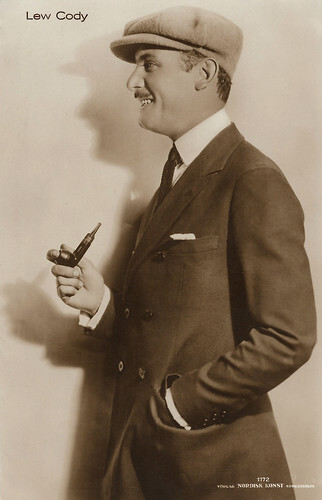
Swedish postcard by Förlag Nordisk Konst, Stockholm, no. 1172.
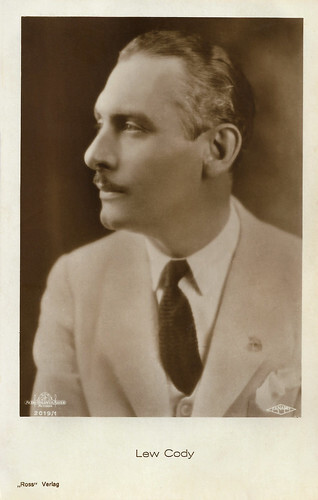
German postcard by Ross Verlag, no. 2019/1, 1927-1928. Photo: MGM / Fanamet.
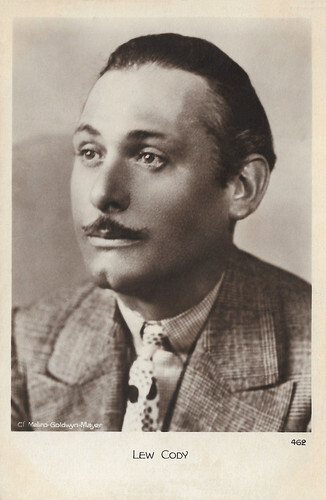
French postcard by Cinémagazine-Edition, no. 462. Photo: Metro-Goldwyn-Mayer.
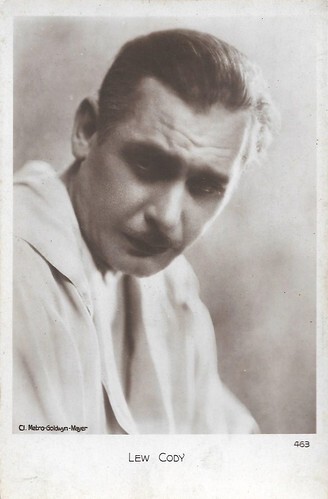
French postcard by Cinémagazine-Edition, no. 463. Photo: Metro-Goldwyn-Mayer.
With his moustache and the air of a seducer
Lew Cody was born Louis Joseph Côté in Waterville, Maine, in 1884. Some sources claim it was Berlin, New Hampshire, where he grew up. Cody was one of the six children of Joseph Côté, a French Canadian, and Elizabeth Côté, née Gifford (some sources say née Herbert). After Elizabeth's death, Louis remarried Marie Lena Rose Toussaint, and they had a daughter named Cecile Côté. The family moved to Berlin, New Hampshire, where his father owned a drugstore. In his youth, Lew worked there as a soda jerk.
He later began studying medicine at McGill University in Montreal. He dropped out and joined a theatre company in North Carolina. He studied drama at the Stanhope Wheatcroft School of Acting in New York and made his debut on the stage in New York in 'Pierre of the Plains'. Cody moved to Los Angeles and began a minor film career at The Balboa Film Studios. He debuted in Harp of Tara (1914), a silent film directed by Raymond B. West and distributed by Mutual.
He then worked for Thomas H. Ince and Mack Sennett, advancing to full-length features by 1917, initially playing villains. With his moustache and the air of a seducer, he became very popular in roles that used his vivacious charm, either as a protagonist or antagonist such as in the comedy The Beloved Cheater (Christy Cabanne, 1919).
He frequently played somewhat dodgy male admirers, which earned him the nickname 'The Male Vamp'. An example is the playboy Schuyler van Sutphen in Cecil B. DeMille 's society comedy Don't Change Your Husband (1919), starring Gloria Swanson . In the late 1910s and early 1920s, Cody wandered from one production company to another: Kay-Bee, Selig, Fox, Universal and many others. He auditioned for the title role in Ernst Lubitsch 's Faust (1923). The project remained unrealised, but Cody's screentest survives in the Library of Congress, along with those of other contestants.
From the mid-1920s until 1930 Cody was a steady actor at MGM, where he often was paired with the French Renée Adorée . They formed an ideal couple in mischievous comedies such as Man and Maid (Victor Schertzinger, 1925), based on a novel by Elinor Glyn. One of his most interesting films was the silent drama The Tower of Lies (Victor Sjöström, 1925), based upon Selma Lagerlöf' s 1914 novel 'The Emperor of Portugallia' and starring Lon Chaney and Norma Shearer . The Tower of Lies is now considered a lost film. The last known surviving copy of the film was reportedly destroyed in the 1965 MGM vault fire.
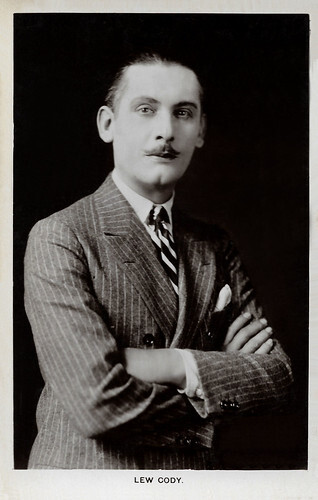
British postcard in the Picturegoer series, London, no. 153.
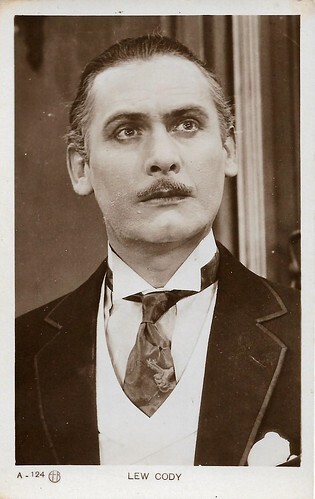
Spanish postcard by EFB (Editorial Fotografica, Barcelona), no. A-124.
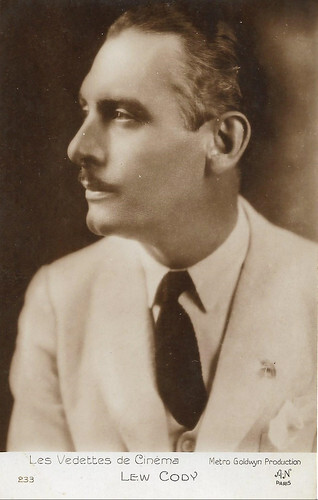
French postcard in the Les Vedettes de Cinéma series by A.N., Paris, no. 233. Photo: Metro Goldwyn Production.
Always married to a famous actress
In the early sound era, Lew Cody again shifted from one company to another. During his career, which would last until 1934, Cody acted in about a hundred films. He was a noted wit and much sought-after as a speaker at Hollywood parties.
Among his important directors were Maurice Tourneur, Frank Borzage, Allan Dwan, Henry King, George Fitzmaurice, and Josef von Sternberg , while he acted opposite female stars such as Norma Talmadge , Barbara LaMarr, Mabel Normand , Norma Shearer , and Marlene Dietrich .
Cody married three times, always with an actress. His first wife was Dorothy Dalton from whom he married and divorced twice: 1910-1911, and 1913-1914. Playing the debonnaire leading man, Cody enjoyed the later single life of 'a man's man', which added to his acting persona.
His second wife was Mabel Normand . In 1926, during a party, Cody asked the famous actress jokingly to marry him and she accepted. They convinced the county judge of Ventura to celebrate the ceremony, but the two never lived together even though they never divorced. Cody was married to Mabel Normand until she died of tuberculosis in 1930. On her grave, the actress's name appears as Mabel Normand-Cody.
Lew Cody's last years were marred by big heart problems. At the age of only fifty, he died of a heart attack at home in Beverly Hills in 1934, immediately after shooting his latest film. Cody was buried at the Saint Peter Catholic cemetery in Lewiston, Maine, in the county of Androscoggin.
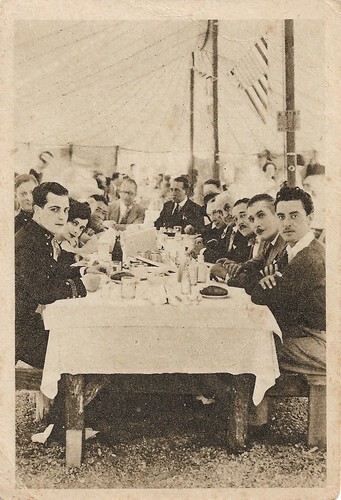
Spanish collector card in the series Los artistas cinematograficos en la intimidad by Amatller, Barcelona, Series A. Ramon Novarro , John Gilbert , Lew Cody, Kathleen Key and other stars at the yearly outdoor MGM lunch. Other actors present are George K. Arthur, Edward Connelly and Frank Currier.
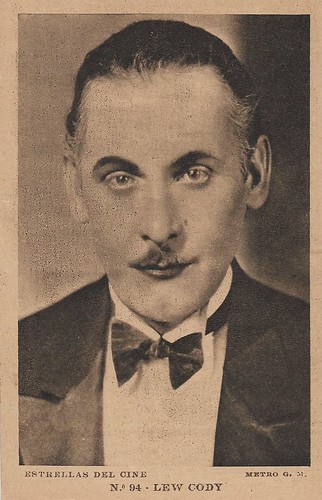
Spanish postcard in the Estrellas del cine series by Editorial Grafica, Barcelona, no. 94. Photo: Metro-Goldwyn-Mayer.
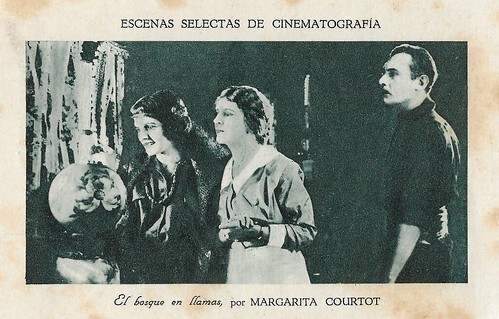
Spanish minicard (collector card) by Escenas selectas de cinematografia, series B, no. 9. Marguerite Courtot as Jacqueline, probably Effie Shannon as her mother, and Lew Cody as Raoul Radon in Jacqueline, or The Blazing Barriers (Dell Henderson, 1923). The Spanish title was El bosque en llamas (The Forest on Fire), and indeed the climax of the film contains a real, big forest fire.
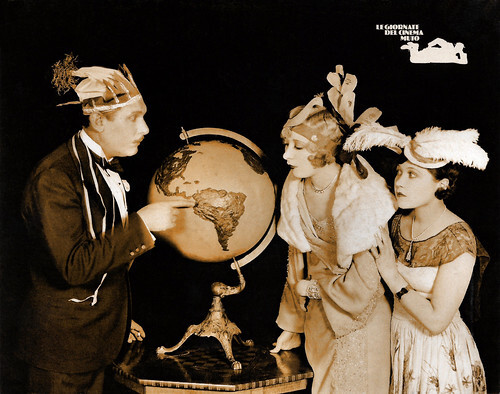
Italian promotion card by Cineteca del Friuli for Le Giornate del Cinema Muto 43 / Pordenone Silent Film Festival 2024. Photo: Lew Cody, Gwen Lee, and Gertrude Short in Adam and Evil (Robert Z. Leonard, 1927).
Sources: (IMDb), Wikipedia (English, German and Italian) and .

Swedish postcard by Förlag Nordisk Konst, Stockholm, no. 1172.

German postcard by Ross Verlag, no. 2019/1, 1927-1928. Photo: MGM / Fanamet.

French postcard by Cinémagazine-Edition, no. 462. Photo: Metro-Goldwyn-Mayer.

French postcard by Cinémagazine-Edition, no. 463. Photo: Metro-Goldwyn-Mayer.
With his moustache and the air of a seducer
Lew Cody was born Louis Joseph Côté in Waterville, Maine, in 1884. Some sources claim it was Berlin, New Hampshire, where he grew up. Cody was one of the six children of Joseph Côté, a French Canadian, and Elizabeth Côté, née Gifford (some sources say née Herbert). After Elizabeth's death, Louis remarried Marie Lena Rose Toussaint, and they had a daughter named Cecile Côté. The family moved to Berlin, New Hampshire, where his father owned a drugstore. In his youth, Lew worked there as a soda jerk.
He later began studying medicine at McGill University in Montreal. He dropped out and joined a theatre company in North Carolina. He studied drama at the Stanhope Wheatcroft School of Acting in New York and made his debut on the stage in New York in 'Pierre of the Plains'. Cody moved to Los Angeles and began a minor film career at The Balboa Film Studios. He debuted in Harp of Tara (1914), a silent film directed by Raymond B. West and distributed by Mutual.
He then worked for Thomas H. Ince and Mack Sennett, advancing to full-length features by 1917, initially playing villains. With his moustache and the air of a seducer, he became very popular in roles that used his vivacious charm, either as a protagonist or antagonist such as in the comedy The Beloved Cheater (Christy Cabanne, 1919).
He frequently played somewhat dodgy male admirers, which earned him the nickname 'The Male Vamp'. An example is the playboy Schuyler van Sutphen in Cecil B. DeMille 's society comedy Don't Change Your Husband (1919), starring Gloria Swanson . In the late 1910s and early 1920s, Cody wandered from one production company to another: Kay-Bee, Selig, Fox, Universal and many others. He auditioned for the title role in Ernst Lubitsch 's Faust (1923). The project remained unrealised, but Cody's screentest survives in the Library of Congress, along with those of other contestants.
From the mid-1920s until 1930 Cody was a steady actor at MGM, where he often was paired with the French Renée Adorée . They formed an ideal couple in mischievous comedies such as Man and Maid (Victor Schertzinger, 1925), based on a novel by Elinor Glyn. One of his most interesting films was the silent drama The Tower of Lies (Victor Sjöström, 1925), based upon Selma Lagerlöf' s 1914 novel 'The Emperor of Portugallia' and starring Lon Chaney and Norma Shearer . The Tower of Lies is now considered a lost film. The last known surviving copy of the film was reportedly destroyed in the 1965 MGM vault fire.

British postcard in the Picturegoer series, London, no. 153.

Spanish postcard by EFB (Editorial Fotografica, Barcelona), no. A-124.

French postcard in the Les Vedettes de Cinéma series by A.N., Paris, no. 233. Photo: Metro Goldwyn Production.
Always married to a famous actress
In the early sound era, Lew Cody again shifted from one company to another. During his career, which would last until 1934, Cody acted in about a hundred films. He was a noted wit and much sought-after as a speaker at Hollywood parties.
Among his important directors were Maurice Tourneur, Frank Borzage, Allan Dwan, Henry King, George Fitzmaurice, and Josef von Sternberg , while he acted opposite female stars such as Norma Talmadge , Barbara LaMarr, Mabel Normand , Norma Shearer , and Marlene Dietrich .
Cody married three times, always with an actress. His first wife was Dorothy Dalton from whom he married and divorced twice: 1910-1911, and 1913-1914. Playing the debonnaire leading man, Cody enjoyed the later single life of 'a man's man', which added to his acting persona.
His second wife was Mabel Normand . In 1926, during a party, Cody asked the famous actress jokingly to marry him and she accepted. They convinced the county judge of Ventura to celebrate the ceremony, but the two never lived together even though they never divorced. Cody was married to Mabel Normand until she died of tuberculosis in 1930. On her grave, the actress's name appears as Mabel Normand-Cody.
Lew Cody's last years were marred by big heart problems. At the age of only fifty, he died of a heart attack at home in Beverly Hills in 1934, immediately after shooting his latest film. Cody was buried at the Saint Peter Catholic cemetery in Lewiston, Maine, in the county of Androscoggin.

Spanish collector card in the series Los artistas cinematograficos en la intimidad by Amatller, Barcelona, Series A. Ramon Novarro , John Gilbert , Lew Cody, Kathleen Key and other stars at the yearly outdoor MGM lunch. Other actors present are George K. Arthur, Edward Connelly and Frank Currier.

Spanish postcard in the Estrellas del cine series by Editorial Grafica, Barcelona, no. 94. Photo: Metro-Goldwyn-Mayer.

Spanish minicard (collector card) by Escenas selectas de cinematografia, series B, no. 9. Marguerite Courtot as Jacqueline, probably Effie Shannon as her mother, and Lew Cody as Raoul Radon in Jacqueline, or The Blazing Barriers (Dell Henderson, 1923). The Spanish title was El bosque en llamas (The Forest on Fire), and indeed the climax of the film contains a real, big forest fire.

Italian promotion card by Cineteca del Friuli for Le Giornate del Cinema Muto 43 / Pordenone Silent Film Festival 2024. Photo: Lew Cody, Gwen Lee, and Gertrude Short in Adam and Evil (Robert Z. Leonard, 1927).
Sources: (IMDb), Wikipedia (English, German and Italian) and .
Published on September 15, 2024 22:00
September 14, 2024
Paul Heidemann
German stage and screen actor Paul Heidemann (1884-1968) was also a film director and producer. In the silent period, he was famous for his character Teddy and his other comical parts. He also played many supporting roles in sound comedies.
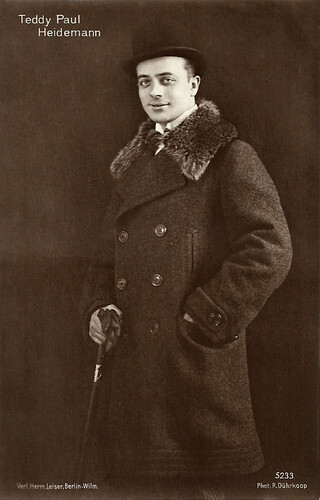
German postcard by Verlag Hermann Leiser, Berlin-Wilm., no. 5233. Photo: R. Dührkoop.
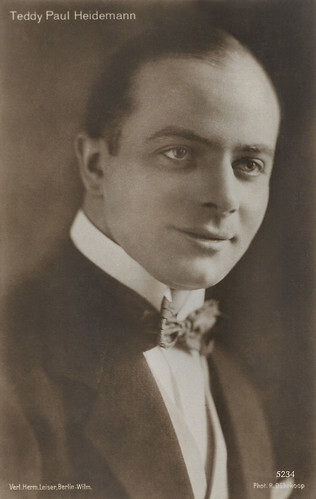
German postcard by Verlag Hermann Leiser, Berlin-Wilm., no. 5234. Photo: R. Dührkoop.
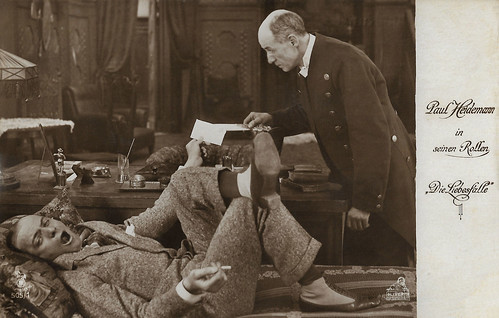
German postcard by Rotophot in the Film Sterne series, no. 505/1. Photo: Oliver-Film. Paul Heidemann in Die Liebesfalle/The Love Trap (N.N., 1917).
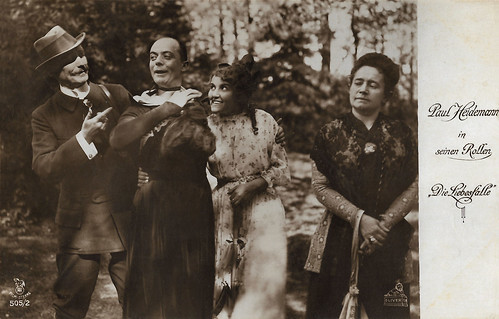
German postcard by Rotophot in the Film Sterne series, no. 505/2. Photo: Oliver-Film. Paul Heidemann in Die Liebesfalle/The Love Trap (N.N., 1917).
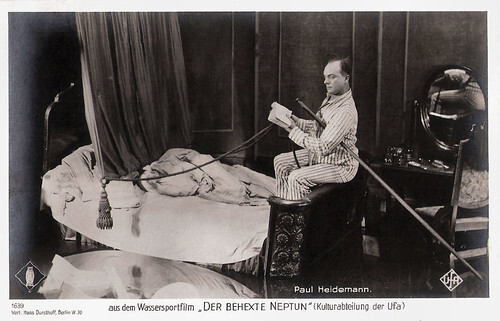
German postcard by Verlag Hans Dursthoff, Berlin, no. 1639. Photo: Ufa. Paul Heidemann in Der behexte Neptun/The Bewitched Neptune (Willi Achsel, 1925).
Talented comedian
Paul Heidemann was born in Cologne, Germany in 1884. After an initial career in the tobacco branch, he took acting lessons from the Meiningen based court actor Leopold Teller.
In 1906 he debuted in Hanau as Prince Karl-Heinz in the operetta 'Alt-Heidelberg' (Old Heidelberg). In 1909, he joined the theatre of Breslau, where he sang in Bruno Granichstaedten’s operetta 'Bub oder Mädel' (Boy or Girl). Here Heidemann created his reputation as talented comedian. On the recommendation of composer Jean Gilbert, he moved to Berlin in 1911, where he debuted in Gilbert’s play 'Die keusche Susanne' (The chaste Susanne).
Franz Porten discovered Heidemann for the cinema, where he played his first lead in Das Brandmal ihrer Vergangenheit/The Stigma of Her Past (1912). It was followed by films such as Das Teufelsloch/The Devil's Hole (Rudolf Del Zopp, 1913), and Vater und Sohn/Father and Son (Afred Halm, 1914) with Leopoldine Konstantin .
From 1913 to 1915 he also played the character Teddy in countless comical shorts, such as Teddy ist herzkrank/Teddy has a heart condition (1914), Teddys Geburtstagsgeschenk/Teddy's Birthday Present (1915) and Teddy züchtet Notkartoffeln/Teddy Breeds Emergency Potatoes (1915). Sometimes he directed these films as well.
Between 1919 and 1923 Heidemann had his own production company, Paul Heidemann-Film GmbH in Berlin, where he played the lead in films initially mostly directed by Erich Schönefelder and later on rather by Georg Schubert or by Heidemann himself. A late example is Eine kleine Freundin braucht ein jeder Mann/Every man Needs A little Friend (Paul Heidemann, 1927), starring Heidemann but also Julius Falkenstein , Hans Albers , Siegfried Arno and Charlotte Ander .
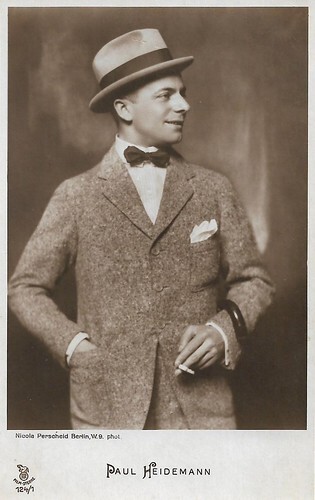
German postcard by Rotophot in the Film Sterne series, no. 124/1. Photo: Nicola Perscheid, Berlin.
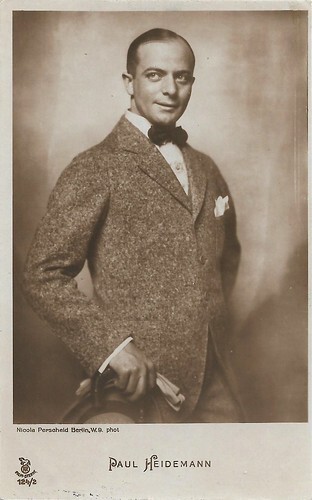
German postcard by Rotophot in the Film Sterne series, no. 124/2. Photo: Nicola Perscheid, Berlin.
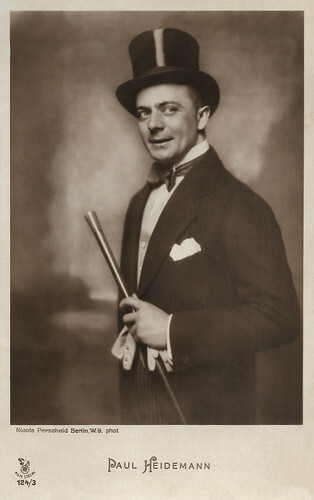
German postcard by Rotophot in the Film Sterne series, no. 124/3. Photo: Nicola Perscheid, Berlin.
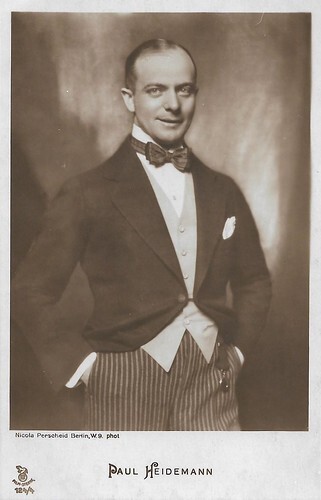
German postcard by Rotophot in the Film Sterne series, no. 124/4. Photo: Nicola Perscheid, Berlin.
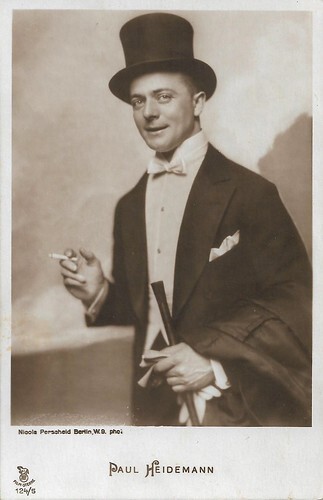
German postcard by Rotophot in the Film Sterne series, no. 124/5. Photo: Nicola Perscheid, Berlin.
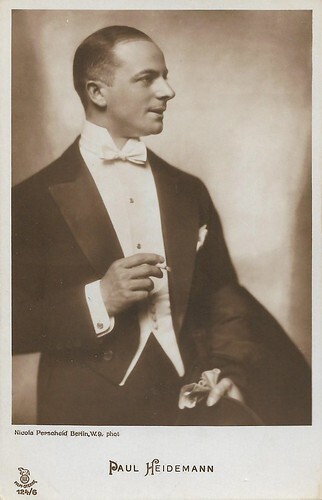
German postcard by Rotophot in the Film Sterne series, no. 124/6. Photo: Nicola Perscheid, Berlin.
Military comedies
In the 1920s, Paul Heidemann became an important supporting actor and sometimes leading man in all kinds of films. He had a supporting part in the silent comedy classic Die Bergkatze/The Wild Cat (Ernst Lubitsch, 1921) featuring Pola Negri as a wild mountain girl and bandit’s daughter.
Heidemann played the lead in the silent historical comedy Der kleine Napoleon/The Little Napoleon (Georg Jacoby, 1923). It depicts the life and amorous adventures of Jérôme Bonaparte, the younger brother of Napoleon (Egon von Hagen), who installed him as King of Westphalia. The film also marked Marlene Dietrich 's film debut and was made by the European Film Alliance, a failed attempt by the American studio Paramount to establish a production base in the lucrative German market. The EFA was wound up shortly after the film's completion, which delayed its release. It finally premièred on 29 November 1923 at the legendary Berlin movie palace Marmorhaus.
He often played in comedies, such Der Sprung ins Leben/Leap Into Life (Johannes Guter, 1923) with Xenia Desni , Das süsse Mädel/The Sweet Girl (Manfred Noa, 1926) with Mary Nolan (in Germany known as Imogene Robertson) and Mary Parker , Die dritte Eskadron/The Third Squadron (Carl Wilhelm, 1926) with Claire Rommer , Flucht aus der Hölle/Escape from Hell (Georg Asagaroff, 1928) with Heidemann, Jean Murat and Agnes Esterhazy , and Flucht vor der Liebe/The Flight From Love (Hans Behrendt, 1930) with Jenny Jugo and Enrico Benfer .
Heidemann acted often as sidekick of the popular actor Hans Albers , such as in Der lachende Ehemann/The Laughing Husband (Rudolf Walther-Fein, Rudolf Dworsky, 1926) and the crime drama Hans in allen Gassen/Hans of all trades (Carl Froelich, 1930).
Other silent films, in which Heidemann played supporting parts were the drama Die Geliebte/The Mistress (Robert Wiene, 1927) with Harry Liedtke , and Unter der Laterne/Under the Lantern (Gerhard Lamprecht, 1928) starring Lissi Arna . And he played the lead in the silent drama Der Zigeunerprimas/The Gypsy Chief (Carl Wilhelm, 1929). Simultaneously Heidemann acted on the Berlin stages, mainly in Operettas.
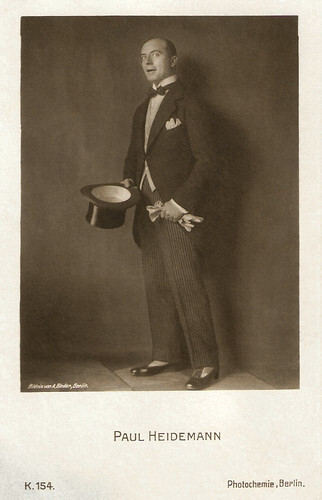
German postcard by Photochemie, Berlin, no. K. 154. Photo: Alex Binder, Berlin.
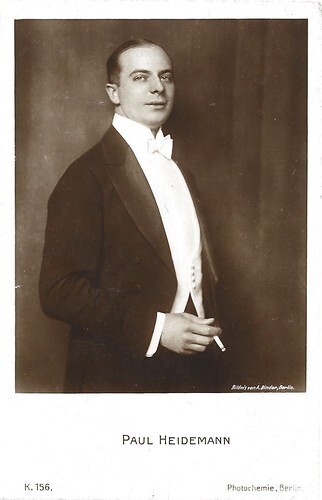
German postcard by Photochemie, Berlin, no. K. 156. Photo: Alex Binder, Berlin.
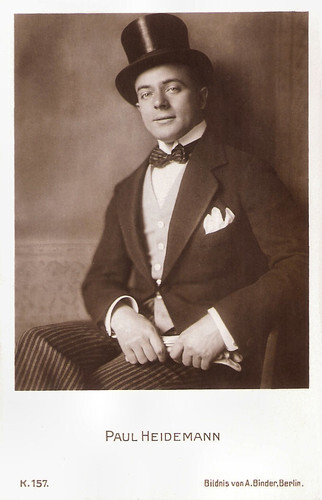
German postcard by Photochemie, Berlin, no. K. 157. Photo: Alex Binder, Berlin.
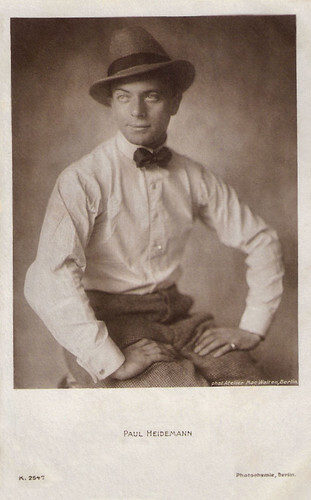
German postcard by Photochemie, Berlin, no. K. 2547. Photo: Atelier Mac Walten, Berlin.
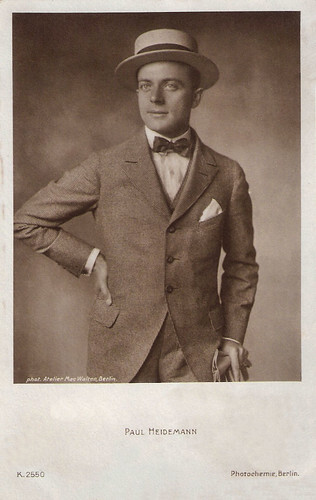
German postcard by Photochemie, Berlin, no. K. 2550. Photo: Atelier Mac Walten, Berlin.
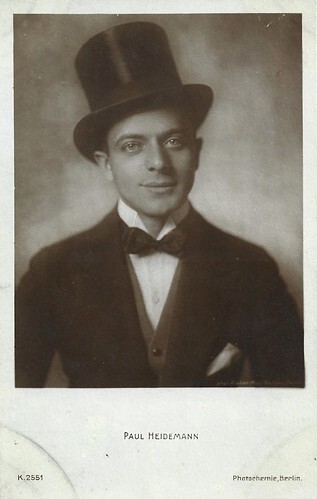
German postcard by Photochemie, Berlin, no. K. 2551. Photo: Atelier Mac Walten, Berlin.
Sidekick
After the introduction of sound film, Paul Heidemann continued to appear in supporting parts in many German films. An example is the comedy Pension Schöller (Georg Jacoby, 1930) starring Paul Henckels and Elga Brink . It is an adaptation of the 1890 play 'Pension Schöller' by Wilhelm Jacoby and Carl Laufs. Georg Jacoby was Wilhelm's son, and made three film adaptation of his father's best known play in 1930, 1952 and 1960. Heidemann played the following year in the romantic comedy Ihre Hoheit befiehlt/Her Grace Commands (Hanns Schwarz, 1931) about a hairdresser ( Käthe von Nagy ) and a greengrocer ( Willy Fritsch ) who fall in love and conceal from each other the truth that they are really a Princess and an army officer in disguise.
When in the early 1930s military comedies were popular, Heidemann acted in various military farces such as Wenn die Soldaten.../When the soldiers... (Luise & Jakob Fleck, 1931) with Otto Wallburg , Schön ist die Manöverzeit/Manoeuver Time Is Fine (Erich Schönfelder, 1931) with Ida Wüst , Die Mutter der Kompanie/The Company's Mother (Franz Seitz senior, 1931), Drei von der Kavallerie/Number Three Cavalryman (Carl Boese, 1932) with Paul Hörbiger and Fritz Kampers , and Liebe in Uniform/Love in Uniform (Georg Jacoby, 1932).
Among his most well-known productions are Der tolle Bomberg/The Mad Bomberg (Georg Asagaroff, 1932) with Heidemann in the lead, Ganovenehre/Crook's Honour (Richard Oswald, 1932) with Fritz Kampers , Paprika (Carl Boese, 1932) with Franciska Gaál , Narren im Schnee/Fools in the Snow (Hans Deppe, 1939) with Anny Ondra , and Schneider Wibbel/Tailor Wibbel (Viktor de Kowa, 1939) with Erich Ponto.
During the Second World War, Heidemann worked again as film director. He staged film comedies, such as Mein Mann darf es nicht wissen/My husband must not know (1940) with Mady Rahl , Krach im Vorderhaus/Noise in the front house (1941) again with Rahl, Weisse Wäsche/White laundry (1942) with Harald Paulsen , and Floh im Ohr/Flea in Her Ear (1943), even if the films were not huge hits.
In the 1950s, he acted both in BRD and DDR films. In East-Germany he played Presskopp in the old Berlin farce Ein Polterabend/A Stag Night (Curt Bois, 1955) and the mayor in Bärenburger Schnurre/Bärenburg Farce (Ralf Kirsten, 1957). He also acted in West-German films like Torreani (Gustav Fröhlich, 1951), Der keusche Josef/The Chaste Joseph (Carl Boese, 1953), Rittmeister Wronski/Cavalry Captain Wronski (Ulrich Erfurth, 1954), Der Mustergatte/The Model Husband (Erik Ode, 1956) and Jede Nacht in einem anderen Bett/Every Night in a Different Bed (Paul Verhoeven, 1957). Paul Heidemann died in Berlin in 1968. He was 83.
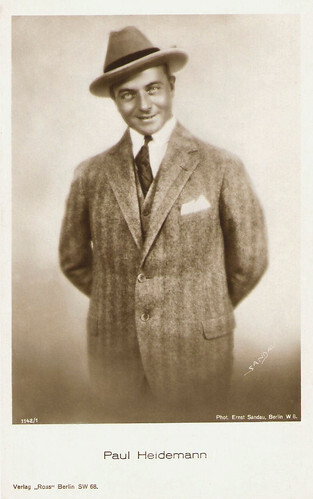
German postcard by Ross Verlag, Berlin, no. 1142/1, 1927-1928. Photo: Ernst Sandau, Berlin.
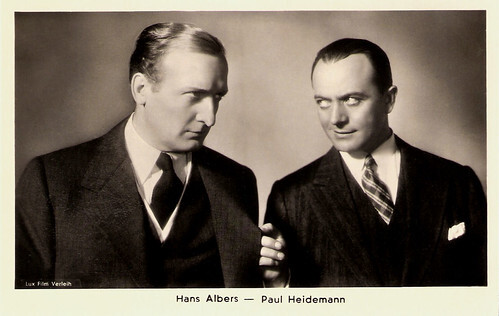
With Hans Albers . Austrian Postcard by Iris Verlag, no. 6699. Photo: Lux Film Verleih.
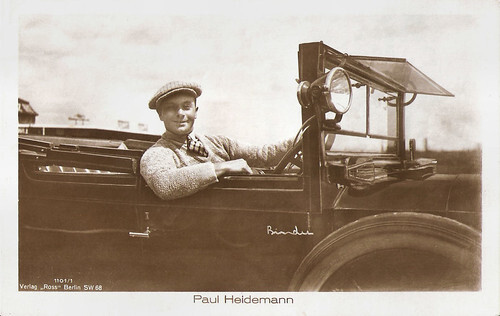
German postcard by Ross Verlag, no. 1101/1, 1927-1928. Photo: Alex Binder, Berlin.
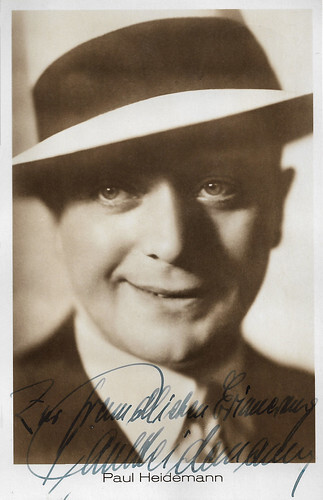
Vintage postcard.
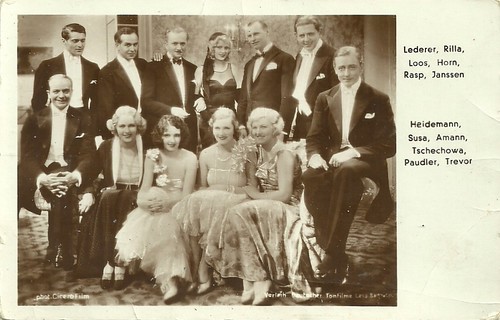
German postcard. Photo: Cicero Film / Distribution Deutsche Tonfilme. The 'fine fleur' of late silent German cinema stars, united for a photo for an early sound film company. Standing left to right: Francis/Franz Lederer, Walter Rilla, Theodor Loos, Camilla Horn, Fritz Rasp and Walter Janssen, Sitting left to right: Paul Heidemann, Charlotte Susa, Betty Amann, Olga Tschechowa, Maria Paudler and Jack Trevor. Might be publicity for the early sound comedy Die grosse Sehnsucht/The Great Longing (Stefan Szekely/Steve Sekely, 1930), in which all acted, mostly as themselves - only Loos and Horn played characters. The plot was an excuse for 35 stars to debut in a talking picture.
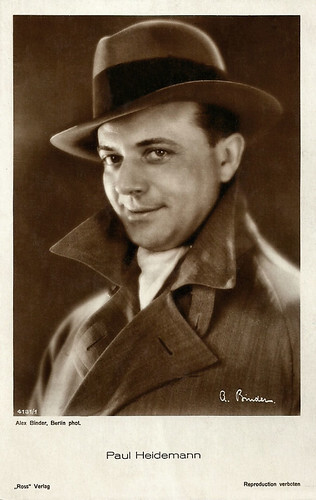
German postcard by Ross Verlag, no. 4181/1, 1929-1930. Photo: Alex Binder, Berlin.
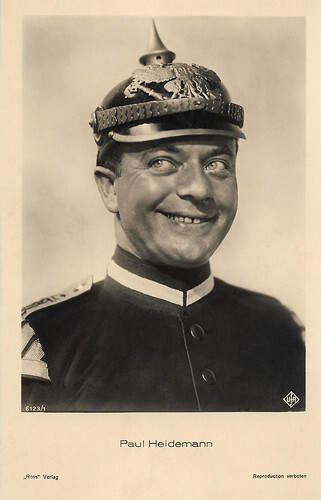
German postcard by Ross Verlag, Berlin, no. 6123/1, 1931-1932. Photo: Ufa. Paul Heidemann in Dienst ist Dienst/Duty is Duty (Carl Boese, 1931).
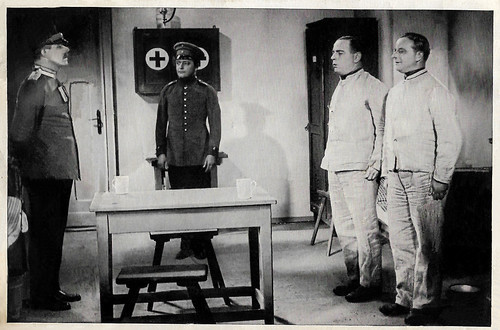
German collectors card in the series 'Vom Werden deutscher Filmkunst - Der Tonfilm', album no. 11, picture no. 139, group 44. Photo: Ufa / Ross Verlag. Fritz Schulz and Paul Heidemann in Dienst ist Dienst/Duty is Duty (Carl Boese, 1931).
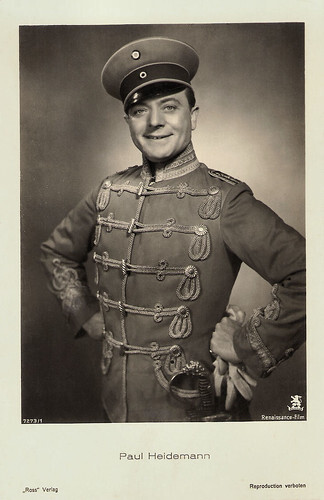
German postcard by Ross Verlag, Berlin, no. 7273/1, 1932-1933. Photo: Renaissance-Film. Paul Heidemann possibly in Annemarie, die Braut der Kompanie/Annemarie, the Bride of the Company (Carl Boese, 1932).
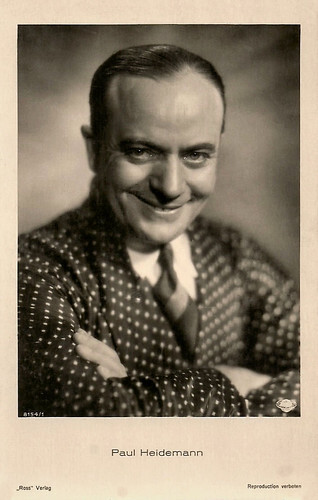
German postcard by Ross Verlag, no. 8154/1, 1933-1934.
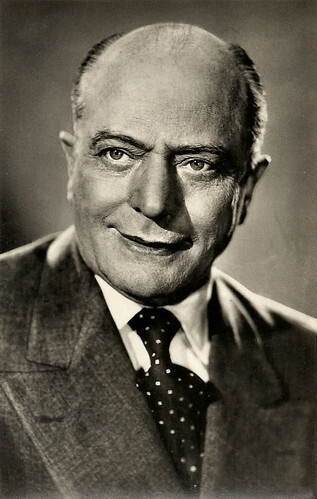
East-German postcard by VEB-Progress Film-Vertrieb, Berlin, no. 176-59. Photo: Defa-Neufeld. Publicity still for Junges Gemüse/Young Vegetables (Günter Reisch, 1956).
Sources: Thomas Staedeli (Cyranos), Volker Wachter (Defa Sternstunden - now defunct), Filmportal.de, Wikipedia (German) and .

German postcard by Verlag Hermann Leiser, Berlin-Wilm., no. 5233. Photo: R. Dührkoop.

German postcard by Verlag Hermann Leiser, Berlin-Wilm., no. 5234. Photo: R. Dührkoop.

German postcard by Rotophot in the Film Sterne series, no. 505/1. Photo: Oliver-Film. Paul Heidemann in Die Liebesfalle/The Love Trap (N.N., 1917).

German postcard by Rotophot in the Film Sterne series, no. 505/2. Photo: Oliver-Film. Paul Heidemann in Die Liebesfalle/The Love Trap (N.N., 1917).

German postcard by Verlag Hans Dursthoff, Berlin, no. 1639. Photo: Ufa. Paul Heidemann in Der behexte Neptun/The Bewitched Neptune (Willi Achsel, 1925).
Talented comedian
Paul Heidemann was born in Cologne, Germany in 1884. After an initial career in the tobacco branch, he took acting lessons from the Meiningen based court actor Leopold Teller.
In 1906 he debuted in Hanau as Prince Karl-Heinz in the operetta 'Alt-Heidelberg' (Old Heidelberg). In 1909, he joined the theatre of Breslau, where he sang in Bruno Granichstaedten’s operetta 'Bub oder Mädel' (Boy or Girl). Here Heidemann created his reputation as talented comedian. On the recommendation of composer Jean Gilbert, he moved to Berlin in 1911, where he debuted in Gilbert’s play 'Die keusche Susanne' (The chaste Susanne).
Franz Porten discovered Heidemann for the cinema, where he played his first lead in Das Brandmal ihrer Vergangenheit/The Stigma of Her Past (1912). It was followed by films such as Das Teufelsloch/The Devil's Hole (Rudolf Del Zopp, 1913), and Vater und Sohn/Father and Son (Afred Halm, 1914) with Leopoldine Konstantin .
From 1913 to 1915 he also played the character Teddy in countless comical shorts, such as Teddy ist herzkrank/Teddy has a heart condition (1914), Teddys Geburtstagsgeschenk/Teddy's Birthday Present (1915) and Teddy züchtet Notkartoffeln/Teddy Breeds Emergency Potatoes (1915). Sometimes he directed these films as well.
Between 1919 and 1923 Heidemann had his own production company, Paul Heidemann-Film GmbH in Berlin, where he played the lead in films initially mostly directed by Erich Schönefelder and later on rather by Georg Schubert or by Heidemann himself. A late example is Eine kleine Freundin braucht ein jeder Mann/Every man Needs A little Friend (Paul Heidemann, 1927), starring Heidemann but also Julius Falkenstein , Hans Albers , Siegfried Arno and Charlotte Ander .

German postcard by Rotophot in the Film Sterne series, no. 124/1. Photo: Nicola Perscheid, Berlin.

German postcard by Rotophot in the Film Sterne series, no. 124/2. Photo: Nicola Perscheid, Berlin.

German postcard by Rotophot in the Film Sterne series, no. 124/3. Photo: Nicola Perscheid, Berlin.

German postcard by Rotophot in the Film Sterne series, no. 124/4. Photo: Nicola Perscheid, Berlin.

German postcard by Rotophot in the Film Sterne series, no. 124/5. Photo: Nicola Perscheid, Berlin.

German postcard by Rotophot in the Film Sterne series, no. 124/6. Photo: Nicola Perscheid, Berlin.
Military comedies
In the 1920s, Paul Heidemann became an important supporting actor and sometimes leading man in all kinds of films. He had a supporting part in the silent comedy classic Die Bergkatze/The Wild Cat (Ernst Lubitsch, 1921) featuring Pola Negri as a wild mountain girl and bandit’s daughter.
Heidemann played the lead in the silent historical comedy Der kleine Napoleon/The Little Napoleon (Georg Jacoby, 1923). It depicts the life and amorous adventures of Jérôme Bonaparte, the younger brother of Napoleon (Egon von Hagen), who installed him as King of Westphalia. The film also marked Marlene Dietrich 's film debut and was made by the European Film Alliance, a failed attempt by the American studio Paramount to establish a production base in the lucrative German market. The EFA was wound up shortly after the film's completion, which delayed its release. It finally premièred on 29 November 1923 at the legendary Berlin movie palace Marmorhaus.
He often played in comedies, such Der Sprung ins Leben/Leap Into Life (Johannes Guter, 1923) with Xenia Desni , Das süsse Mädel/The Sweet Girl (Manfred Noa, 1926) with Mary Nolan (in Germany known as Imogene Robertson) and Mary Parker , Die dritte Eskadron/The Third Squadron (Carl Wilhelm, 1926) with Claire Rommer , Flucht aus der Hölle/Escape from Hell (Georg Asagaroff, 1928) with Heidemann, Jean Murat and Agnes Esterhazy , and Flucht vor der Liebe/The Flight From Love (Hans Behrendt, 1930) with Jenny Jugo and Enrico Benfer .
Heidemann acted often as sidekick of the popular actor Hans Albers , such as in Der lachende Ehemann/The Laughing Husband (Rudolf Walther-Fein, Rudolf Dworsky, 1926) and the crime drama Hans in allen Gassen/Hans of all trades (Carl Froelich, 1930).
Other silent films, in which Heidemann played supporting parts were the drama Die Geliebte/The Mistress (Robert Wiene, 1927) with Harry Liedtke , and Unter der Laterne/Under the Lantern (Gerhard Lamprecht, 1928) starring Lissi Arna . And he played the lead in the silent drama Der Zigeunerprimas/The Gypsy Chief (Carl Wilhelm, 1929). Simultaneously Heidemann acted on the Berlin stages, mainly in Operettas.

German postcard by Photochemie, Berlin, no. K. 154. Photo: Alex Binder, Berlin.

German postcard by Photochemie, Berlin, no. K. 156. Photo: Alex Binder, Berlin.

German postcard by Photochemie, Berlin, no. K. 157. Photo: Alex Binder, Berlin.

German postcard by Photochemie, Berlin, no. K. 2547. Photo: Atelier Mac Walten, Berlin.

German postcard by Photochemie, Berlin, no. K. 2550. Photo: Atelier Mac Walten, Berlin.

German postcard by Photochemie, Berlin, no. K. 2551. Photo: Atelier Mac Walten, Berlin.
Sidekick
After the introduction of sound film, Paul Heidemann continued to appear in supporting parts in many German films. An example is the comedy Pension Schöller (Georg Jacoby, 1930) starring Paul Henckels and Elga Brink . It is an adaptation of the 1890 play 'Pension Schöller' by Wilhelm Jacoby and Carl Laufs. Georg Jacoby was Wilhelm's son, and made three film adaptation of his father's best known play in 1930, 1952 and 1960. Heidemann played the following year in the romantic comedy Ihre Hoheit befiehlt/Her Grace Commands (Hanns Schwarz, 1931) about a hairdresser ( Käthe von Nagy ) and a greengrocer ( Willy Fritsch ) who fall in love and conceal from each other the truth that they are really a Princess and an army officer in disguise.
When in the early 1930s military comedies were popular, Heidemann acted in various military farces such as Wenn die Soldaten.../When the soldiers... (Luise & Jakob Fleck, 1931) with Otto Wallburg , Schön ist die Manöverzeit/Manoeuver Time Is Fine (Erich Schönfelder, 1931) with Ida Wüst , Die Mutter der Kompanie/The Company's Mother (Franz Seitz senior, 1931), Drei von der Kavallerie/Number Three Cavalryman (Carl Boese, 1932) with Paul Hörbiger and Fritz Kampers , and Liebe in Uniform/Love in Uniform (Georg Jacoby, 1932).
Among his most well-known productions are Der tolle Bomberg/The Mad Bomberg (Georg Asagaroff, 1932) with Heidemann in the lead, Ganovenehre/Crook's Honour (Richard Oswald, 1932) with Fritz Kampers , Paprika (Carl Boese, 1932) with Franciska Gaál , Narren im Schnee/Fools in the Snow (Hans Deppe, 1939) with Anny Ondra , and Schneider Wibbel/Tailor Wibbel (Viktor de Kowa, 1939) with Erich Ponto.
During the Second World War, Heidemann worked again as film director. He staged film comedies, such as Mein Mann darf es nicht wissen/My husband must not know (1940) with Mady Rahl , Krach im Vorderhaus/Noise in the front house (1941) again with Rahl, Weisse Wäsche/White laundry (1942) with Harald Paulsen , and Floh im Ohr/Flea in Her Ear (1943), even if the films were not huge hits.
In the 1950s, he acted both in BRD and DDR films. In East-Germany he played Presskopp in the old Berlin farce Ein Polterabend/A Stag Night (Curt Bois, 1955) and the mayor in Bärenburger Schnurre/Bärenburg Farce (Ralf Kirsten, 1957). He also acted in West-German films like Torreani (Gustav Fröhlich, 1951), Der keusche Josef/The Chaste Joseph (Carl Boese, 1953), Rittmeister Wronski/Cavalry Captain Wronski (Ulrich Erfurth, 1954), Der Mustergatte/The Model Husband (Erik Ode, 1956) and Jede Nacht in einem anderen Bett/Every Night in a Different Bed (Paul Verhoeven, 1957). Paul Heidemann died in Berlin in 1968. He was 83.

German postcard by Ross Verlag, Berlin, no. 1142/1, 1927-1928. Photo: Ernst Sandau, Berlin.

With Hans Albers . Austrian Postcard by Iris Verlag, no. 6699. Photo: Lux Film Verleih.

German postcard by Ross Verlag, no. 1101/1, 1927-1928. Photo: Alex Binder, Berlin.

Vintage postcard.

German postcard. Photo: Cicero Film / Distribution Deutsche Tonfilme. The 'fine fleur' of late silent German cinema stars, united for a photo for an early sound film company. Standing left to right: Francis/Franz Lederer, Walter Rilla, Theodor Loos, Camilla Horn, Fritz Rasp and Walter Janssen, Sitting left to right: Paul Heidemann, Charlotte Susa, Betty Amann, Olga Tschechowa, Maria Paudler and Jack Trevor. Might be publicity for the early sound comedy Die grosse Sehnsucht/The Great Longing (Stefan Szekely/Steve Sekely, 1930), in which all acted, mostly as themselves - only Loos and Horn played characters. The plot was an excuse for 35 stars to debut in a talking picture.

German postcard by Ross Verlag, no. 4181/1, 1929-1930. Photo: Alex Binder, Berlin.

German postcard by Ross Verlag, Berlin, no. 6123/1, 1931-1932. Photo: Ufa. Paul Heidemann in Dienst ist Dienst/Duty is Duty (Carl Boese, 1931).

German collectors card in the series 'Vom Werden deutscher Filmkunst - Der Tonfilm', album no. 11, picture no. 139, group 44. Photo: Ufa / Ross Verlag. Fritz Schulz and Paul Heidemann in Dienst ist Dienst/Duty is Duty (Carl Boese, 1931).

German postcard by Ross Verlag, Berlin, no. 7273/1, 1932-1933. Photo: Renaissance-Film. Paul Heidemann possibly in Annemarie, die Braut der Kompanie/Annemarie, the Bride of the Company (Carl Boese, 1932).

German postcard by Ross Verlag, no. 8154/1, 1933-1934.

East-German postcard by VEB-Progress Film-Vertrieb, Berlin, no. 176-59. Photo: Defa-Neufeld. Publicity still for Junges Gemüse/Young Vegetables (Günter Reisch, 1956).
Sources: Thomas Staedeli (Cyranos), Volker Wachter (Defa Sternstunden - now defunct), Filmportal.de, Wikipedia (German) and .
Published on September 14, 2024 22:00
September 13, 2024
Mehdi El Glaoui
French-Moroccan actor, director and screenwriter Mehdi El Glaoui (1956) is the son of film star and author Cécile Aubry from her marriage to the eldest son of the Pasha of Marrakech. As a child, Mehdi was the cute star of his mother’s TV series Belle et Sébastien/Belle and Sebastian (1965) and its sequels Sébastien parmi les hommes/Belle, Sebastian and the Horses (1968) and Sébastien et la Mary-Morgane/Sebastian and the Mary Morgan (1970). The three popular series were also edited into feature films.
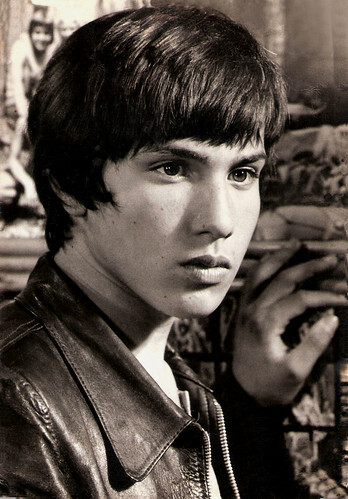
French autograph card. Mehdi El Glaoui in the TV series Le jeune Fabre/The Young Fabre (Cécile Aubry, 1973).
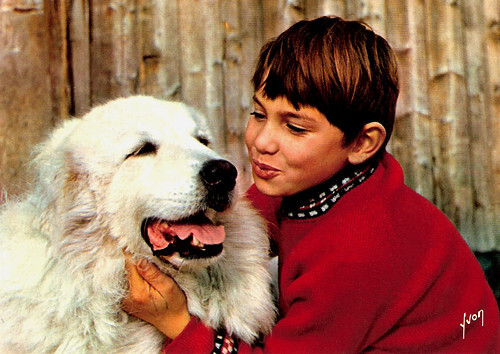
French postcard by Editions d'art Yvon, Paris, no. 6. Photo: RTF / Gaumont. Mehdi El Glaoui as Sebastien with Belle in Sébastien parmi les hommes/Belle, Sebastian and the Horses (Cécile Aubry, 1968).
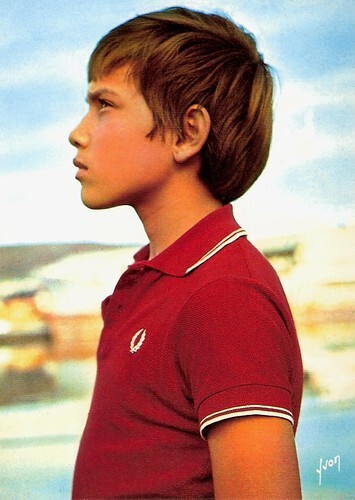
French postcard by Editions d'art Yvon, Paris. Photo: RTF, Gaumont Télévision International and Téléclip. Mehdi El Glaoui as Sebastien in the film and TV series Sebastien et la Mary-Morgane (Cécile Aubry, 1970).
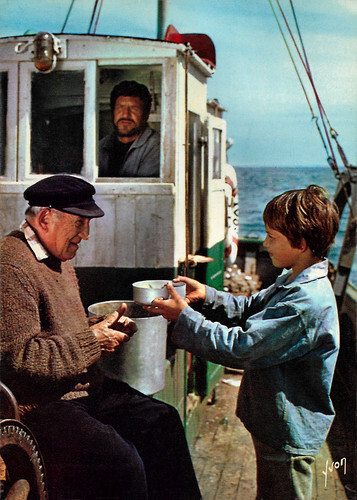
French postcard by Editions d'art Yvon, Paris, no. 40/001-11. Photo: RTF / Gaumont / Téléclip. Mehdi El Glaoui and Charles Vanel in Sebastien et le Mary Morgane/Sebastian and the Mary Morgan (Cécile Aubry, 1970).
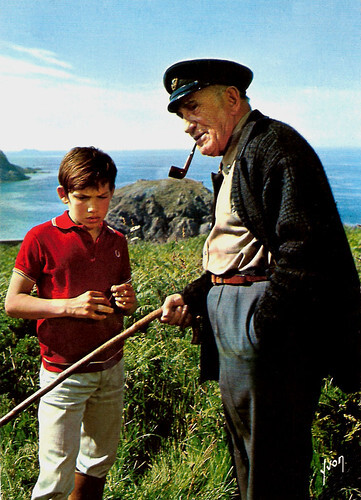
French postcard by Editions d'art Yvon, Paris, no. 40/001-12. Photo: RTF / Gaumont / Téléclip. Mehdi El Glaoui and Charles Vanel in Sebastien et le Mary Morgane/Sebastian and the Mary Morgan (Cécile Aubry, 1970). Sent by mail in 1970.
Lonely boys abandoned by their fathers
Mehdi El Mazouari El Glaoui was born in Choisy-le-Roi, France in 1956. He is the son of French author and actress Cécile Aubry and Moroccan aristocrat Si Brahim El Glaoui, caïd (local administrator) of Telouet and grandson of Thami El Glaoui, the Pasha of Marrakech. His mother and father had met during location shooting in Morocco for the Hollywood production The Black Rose (Henry Hathaway, 1951) in which Aubry co-starred with Tyrone Power and Orson Welles . In 1954, they secretly married and Mehdi was born at the Prince’s country house, the Blue Mill, some 25 miles from Paris. The name 'Mehdi' means 'guided by God' in Arabic.
At the age of 5, Mehdi made his acting début in the TV series Poly (1961–1973), produced by his mother. Poly is a pony and all other actors in the series were local amateurs, whose voices were dubbed later by professionals. Medhi’s natural acting in the series was acclaimed.
From 1965 on, he became internationally famous as Sébastien, the main character in the French TV series Belle et Sébastien/Belle and Sebastian (1965) also created (novelist, screenwriter, lyricist, narrator and co-director) by his mother. The series about a six-year-old orphan boy and his Pyrenean Mountain dog Belle was a popular success in many European countries. Flanker, the dog who played Belle, was an 18-month-old male. Directing Flanker on location was especially hard because the dog wasn't trained at all. Lots of chocolate was used to handle him on the set. One day he ran away just to drink from a mountain stream twelve miles away, and the cast and crew had to wait for his return.
Cécile Aubry was asked by the production company to write a sequel to the series. So she talked to her son Mehdi El Glaoui if he wanted to do it again. He agreed but requested her to set it during the summer, and include horses. In Sébastien parmi les hommes/Belle, Sebastian and the Horses (1968), Sebastian's father Pierre Maréchal (Claude Giraud) finds out that Sebastian is alive and invites him over to his horse ranch. Things soon get complicated when Pierre's rich fiancée finds out about Sebastian's existence. The theme song ‘L'oiseau’ (The Bird) from the second series sung by the then 8-year-old Bruno Victoire Polius, sold more than 1.6 million times.
In the third series, Sébastien et la Mary-Morgane/Sebastian and the Mary Morgan (1970), Belle has died of old age, but Sébastien falls in love with another dog. During the summer holidays, Sébastien is sent to his great-uncle Louis in Bretagne ( Charles Vanel ), an eccentric captain of a fishing vessel, named the Mary-Morgane. In contact with the uncle's servants Jonathan and Clarisse, and the daughter of the uncle's associate, Sébastien hears about the uncle's past as a resistance fighter and the loss of his wife and son. In an interview with Cécile Aubry and Mehdi El Glaoui for the DVD release of Belle et Sébastien, she said that the fact that Mehdi hardly knew his father, who she separated from soon after Mehdi's birth, inspired her to write stories for him about lonely boys abandoned by or estranged from their fathers. This is true of this series, and also of the TV series Le jeune Fabre/The Young Fabre (1973). Mehdi played a young teenager who is looking for his real father. He is expelled from his school and travels to Paris to experiment with life and love.
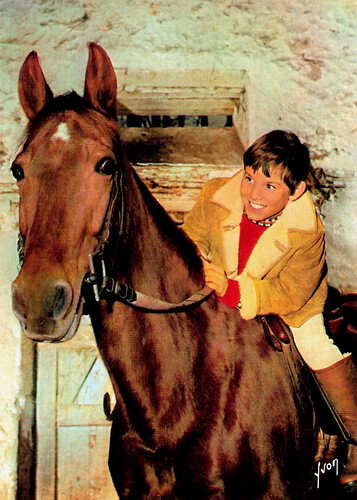
French postcard by Editions d'art Yvon, Paris, no. 1. Photo: RTF / Gaumont. Mehdi El Glaoui as Sébastien in Sébastien parmi les hommes/Belle, Sebastian and the Horses (Cécile Aubry, 1968).
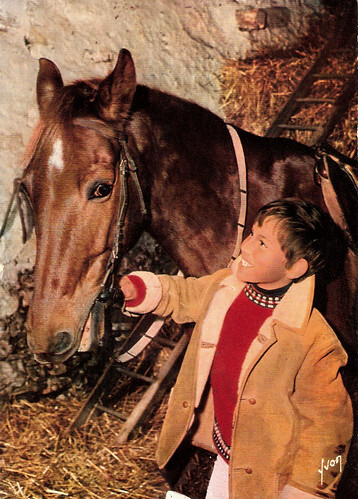
French postcard by Editions d'art Yvon, Paris, no. 2. Photo: RTF / Gaumont. Mehdi El Glaoui as Sébastien in Sébastien parmi les hommes/Belle, Sebastian and the Horses (Cécile Aubry, 1968).
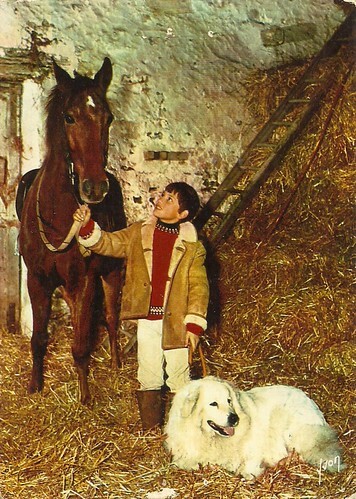
French postcard by Editions d'art Yvon, Paris, no. 7. Photo: RTF / Gaumont. Mehdi El Glaoui as Sébastien in Sébastien parmi les hommes (Cécile Aubry, 1968).
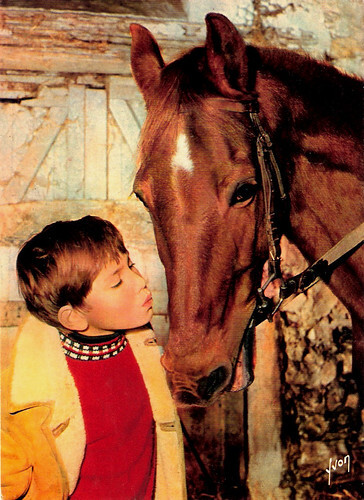
French postcard by Editions d'art Yvon, Paris, no. 81. Photo: RTF / Gaumont. Mehdi El Glaoui as Sébastien in Sébastien parmi les hommes/Belle, Sebastian and the Horses (Cécile Aubry, 1968).
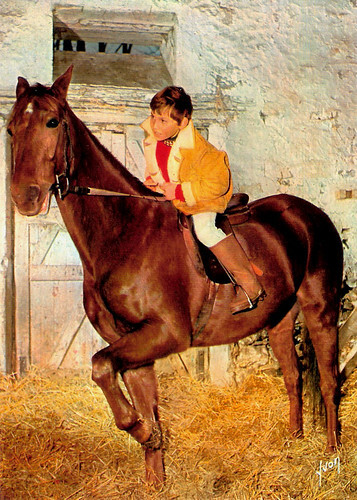
French postcard by Editions d'art Yvon, Paris, no. 8. Photo: RTF / Gaumont. Mehdi El Glaoui as Sébastien in Sébastien parmi les hommes/Belle, Sebastian and the Horses (Cécile Aubry, 1968).
César as director for the Best Short Fiction Film
In real life, the 16-year-old Mehdi El Glaoui also applied for emancipation after a childhood marked by a very present mother and a distant father. With his mother's agreement, he left for the Cantal region where he lived until the age of 35. He pursued a career as a film actor, assistant director and director of dramas, documentaries and commercials.
He appeared opposite Romy Schneider and Nino Castelnuovo in the film Un amour de pluie/Loving in the Rain (Jean-Claude Brialy, 1974) and with Jane Birkin and Patrick Dewaere in the sexy film comedy Catherine et Cie/Catherine & Co (Michel Boisrond, 1975).
During the 1980s and 1990s, he appeared in several TV series such as Kick, Raoul, la moto, les jeunes et les autres (1980) and in a film, the thriller Le cousin/The Informer (Alain Corneau, 1997) starring Patrick Timsit. He also wrote and directed the short film Première classe/First Class (Mehdi El Glaoui,1984) with Francis Huster and André Dussolier. In 1985, he won the César as director for the Best Short Fiction Film for it.
After a decade of absence, he appeared again on screen in the French TV programs 12-14 (2005) and Pour le plaisir (2006). He revealed that he lived near Dax, Les Landes, collected classic cars and ran a musical café. He directed another film, Mao est mort/Mao Is Dead (Mehdi El Glaoui, 2008). In 2013 Mehdi returned to the cinema screens in the remake Belle et Sébastien (Nicolas Vanier, 2013) starring Tchéky Karyo and Félix Bossuet as Sébastien. Mehdi played a supporting part in the film. In the same year, he also published his autobiography, ‘La Belle Histoire de Sébastien’.
Since 2011, Mehdi El Glaoui has been married to actress Virginie Stevenoot. They met on stage and opened a theatre in Biarritz in 2022. A few side notes. Bruno Victoire Polius, who sang ‘L’Oiseau’ for Sébastien parmi les hommes, shot to fame as a teenager. He was the lead singer of Les Poppys's hit single ‘Non non rien n'a changé’ (1971). Harry Trowbridge, also of Les Poppys, recorded ‘La sirène aux longs cheveux’ for the third series, Sébastien en de Mary-Morgane (1970). The TV series Belle et Sébastien had a lasting impact on an entire generation. The Scottish indie pop band Belle and Sebastian took their name from the TV series. The sleeve notes for their album ‘The Boy With The Arab Strap' (1998) state: "Although it is little to do with the eight of us playing music, that is where the name came from, and we are grateful to Madame Cecile Aubry for letting us use the name until now and we pay homage to her work."
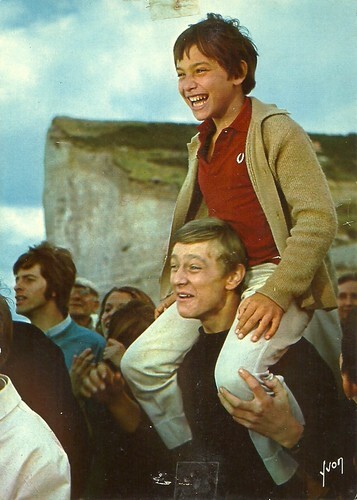
French postcard by Editions d'art Yvon, Paris, no. 40/001-14. Photo: RTF / Gaumont / Téléclip. Publicity still for the film Sebastien et la Mary-Morgane (Cécile Aubry, 1970) with Mehdi El Glaoui.
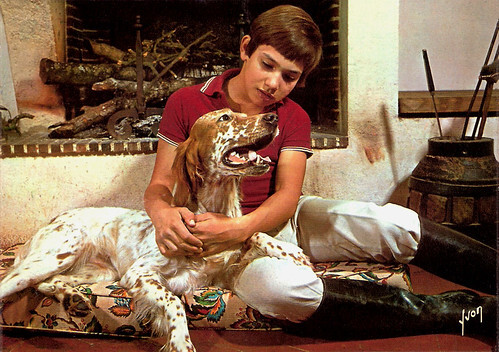
French postcard by Editions d'art Yvon, Paris, no. 40/001-16. Photo: RTF / Gaumont / Téléclip. Publicity still for the film Sebastien et la Mary-Morgane (Cécile Aubry, 1970) with Mehdi El Glaoui.
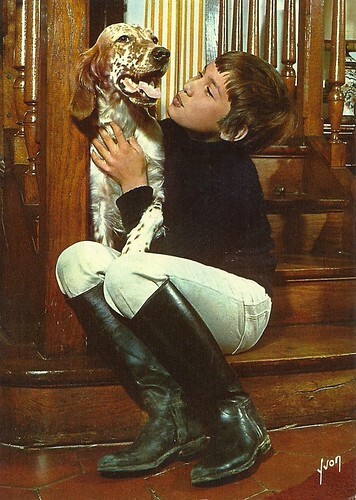
French postcard by Editions d'art Yvon, Paris, no. 40/001-18. Photo: RTF / Gaumont / Téléclip. Publicity still for the film Sebastien et la Mary-Morgane (Cécile Aubry, 1970) with Mehdi El Glaoui.
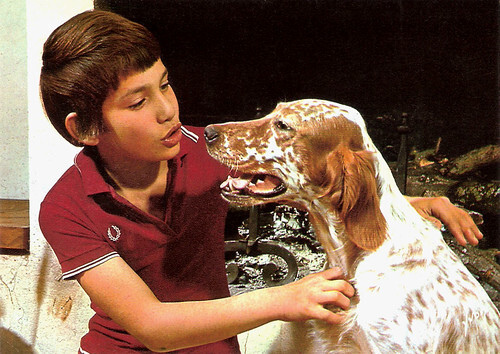
French postcard by Editions d'art Yvon, Paris, no. 40/001-19. Photo: RTF / Gaumont / Téléclip. Publicity still for the film Sebastien et la Mary-Morgane (Cécile Aubry, 1970) with Mehdi El Glaoui.
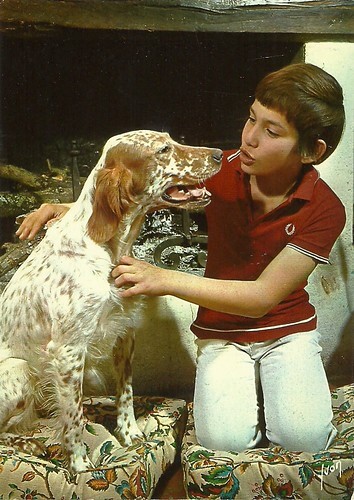
French postcard by Editions d'art Yvon, Paris, no. 40/001-20. Photo: RTF / Gaumont / Téléclip. Publicity still for the film Sebastien et la Mary-Morgane (Cécile Aubry, 1970) with Mehdi El Glaoui.
Sources: Wikipedia (Dutch, French and English), and .

French autograph card. Mehdi El Glaoui in the TV series Le jeune Fabre/The Young Fabre (Cécile Aubry, 1973).

French postcard by Editions d'art Yvon, Paris, no. 6. Photo: RTF / Gaumont. Mehdi El Glaoui as Sebastien with Belle in Sébastien parmi les hommes/Belle, Sebastian and the Horses (Cécile Aubry, 1968).

French postcard by Editions d'art Yvon, Paris. Photo: RTF, Gaumont Télévision International and Téléclip. Mehdi El Glaoui as Sebastien in the film and TV series Sebastien et la Mary-Morgane (Cécile Aubry, 1970).

French postcard by Editions d'art Yvon, Paris, no. 40/001-11. Photo: RTF / Gaumont / Téléclip. Mehdi El Glaoui and Charles Vanel in Sebastien et le Mary Morgane/Sebastian and the Mary Morgan (Cécile Aubry, 1970).

French postcard by Editions d'art Yvon, Paris, no. 40/001-12. Photo: RTF / Gaumont / Téléclip. Mehdi El Glaoui and Charles Vanel in Sebastien et le Mary Morgane/Sebastian and the Mary Morgan (Cécile Aubry, 1970). Sent by mail in 1970.
Lonely boys abandoned by their fathers
Mehdi El Mazouari El Glaoui was born in Choisy-le-Roi, France in 1956. He is the son of French author and actress Cécile Aubry and Moroccan aristocrat Si Brahim El Glaoui, caïd (local administrator) of Telouet and grandson of Thami El Glaoui, the Pasha of Marrakech. His mother and father had met during location shooting in Morocco for the Hollywood production The Black Rose (Henry Hathaway, 1951) in which Aubry co-starred with Tyrone Power and Orson Welles . In 1954, they secretly married and Mehdi was born at the Prince’s country house, the Blue Mill, some 25 miles from Paris. The name 'Mehdi' means 'guided by God' in Arabic.
At the age of 5, Mehdi made his acting début in the TV series Poly (1961–1973), produced by his mother. Poly is a pony and all other actors in the series were local amateurs, whose voices were dubbed later by professionals. Medhi’s natural acting in the series was acclaimed.
From 1965 on, he became internationally famous as Sébastien, the main character in the French TV series Belle et Sébastien/Belle and Sebastian (1965) also created (novelist, screenwriter, lyricist, narrator and co-director) by his mother. The series about a six-year-old orphan boy and his Pyrenean Mountain dog Belle was a popular success in many European countries. Flanker, the dog who played Belle, was an 18-month-old male. Directing Flanker on location was especially hard because the dog wasn't trained at all. Lots of chocolate was used to handle him on the set. One day he ran away just to drink from a mountain stream twelve miles away, and the cast and crew had to wait for his return.
Cécile Aubry was asked by the production company to write a sequel to the series. So she talked to her son Mehdi El Glaoui if he wanted to do it again. He agreed but requested her to set it during the summer, and include horses. In Sébastien parmi les hommes/Belle, Sebastian and the Horses (1968), Sebastian's father Pierre Maréchal (Claude Giraud) finds out that Sebastian is alive and invites him over to his horse ranch. Things soon get complicated when Pierre's rich fiancée finds out about Sebastian's existence. The theme song ‘L'oiseau’ (The Bird) from the second series sung by the then 8-year-old Bruno Victoire Polius, sold more than 1.6 million times.
In the third series, Sébastien et la Mary-Morgane/Sebastian and the Mary Morgan (1970), Belle has died of old age, but Sébastien falls in love with another dog. During the summer holidays, Sébastien is sent to his great-uncle Louis in Bretagne ( Charles Vanel ), an eccentric captain of a fishing vessel, named the Mary-Morgane. In contact with the uncle's servants Jonathan and Clarisse, and the daughter of the uncle's associate, Sébastien hears about the uncle's past as a resistance fighter and the loss of his wife and son. In an interview with Cécile Aubry and Mehdi El Glaoui for the DVD release of Belle et Sébastien, she said that the fact that Mehdi hardly knew his father, who she separated from soon after Mehdi's birth, inspired her to write stories for him about lonely boys abandoned by or estranged from their fathers. This is true of this series, and also of the TV series Le jeune Fabre/The Young Fabre (1973). Mehdi played a young teenager who is looking for his real father. He is expelled from his school and travels to Paris to experiment with life and love.

French postcard by Editions d'art Yvon, Paris, no. 1. Photo: RTF / Gaumont. Mehdi El Glaoui as Sébastien in Sébastien parmi les hommes/Belle, Sebastian and the Horses (Cécile Aubry, 1968).

French postcard by Editions d'art Yvon, Paris, no. 2. Photo: RTF / Gaumont. Mehdi El Glaoui as Sébastien in Sébastien parmi les hommes/Belle, Sebastian and the Horses (Cécile Aubry, 1968).

French postcard by Editions d'art Yvon, Paris, no. 7. Photo: RTF / Gaumont. Mehdi El Glaoui as Sébastien in Sébastien parmi les hommes (Cécile Aubry, 1968).

French postcard by Editions d'art Yvon, Paris, no. 81. Photo: RTF / Gaumont. Mehdi El Glaoui as Sébastien in Sébastien parmi les hommes/Belle, Sebastian and the Horses (Cécile Aubry, 1968).

French postcard by Editions d'art Yvon, Paris, no. 8. Photo: RTF / Gaumont. Mehdi El Glaoui as Sébastien in Sébastien parmi les hommes/Belle, Sebastian and the Horses (Cécile Aubry, 1968).
César as director for the Best Short Fiction Film
In real life, the 16-year-old Mehdi El Glaoui also applied for emancipation after a childhood marked by a very present mother and a distant father. With his mother's agreement, he left for the Cantal region where he lived until the age of 35. He pursued a career as a film actor, assistant director and director of dramas, documentaries and commercials.
He appeared opposite Romy Schneider and Nino Castelnuovo in the film Un amour de pluie/Loving in the Rain (Jean-Claude Brialy, 1974) and with Jane Birkin and Patrick Dewaere in the sexy film comedy Catherine et Cie/Catherine & Co (Michel Boisrond, 1975).
During the 1980s and 1990s, he appeared in several TV series such as Kick, Raoul, la moto, les jeunes et les autres (1980) and in a film, the thriller Le cousin/The Informer (Alain Corneau, 1997) starring Patrick Timsit. He also wrote and directed the short film Première classe/First Class (Mehdi El Glaoui,1984) with Francis Huster and André Dussolier. In 1985, he won the César as director for the Best Short Fiction Film for it.
After a decade of absence, he appeared again on screen in the French TV programs 12-14 (2005) and Pour le plaisir (2006). He revealed that he lived near Dax, Les Landes, collected classic cars and ran a musical café. He directed another film, Mao est mort/Mao Is Dead (Mehdi El Glaoui, 2008). In 2013 Mehdi returned to the cinema screens in the remake Belle et Sébastien (Nicolas Vanier, 2013) starring Tchéky Karyo and Félix Bossuet as Sébastien. Mehdi played a supporting part in the film. In the same year, he also published his autobiography, ‘La Belle Histoire de Sébastien’.
Since 2011, Mehdi El Glaoui has been married to actress Virginie Stevenoot. They met on stage and opened a theatre in Biarritz in 2022. A few side notes. Bruno Victoire Polius, who sang ‘L’Oiseau’ for Sébastien parmi les hommes, shot to fame as a teenager. He was the lead singer of Les Poppys's hit single ‘Non non rien n'a changé’ (1971). Harry Trowbridge, also of Les Poppys, recorded ‘La sirène aux longs cheveux’ for the third series, Sébastien en de Mary-Morgane (1970). The TV series Belle et Sébastien had a lasting impact on an entire generation. The Scottish indie pop band Belle and Sebastian took their name from the TV series. The sleeve notes for their album ‘The Boy With The Arab Strap' (1998) state: "Although it is little to do with the eight of us playing music, that is where the name came from, and we are grateful to Madame Cecile Aubry for letting us use the name until now and we pay homage to her work."

French postcard by Editions d'art Yvon, Paris, no. 40/001-14. Photo: RTF / Gaumont / Téléclip. Publicity still for the film Sebastien et la Mary-Morgane (Cécile Aubry, 1970) with Mehdi El Glaoui.

French postcard by Editions d'art Yvon, Paris, no. 40/001-16. Photo: RTF / Gaumont / Téléclip. Publicity still for the film Sebastien et la Mary-Morgane (Cécile Aubry, 1970) with Mehdi El Glaoui.

French postcard by Editions d'art Yvon, Paris, no. 40/001-18. Photo: RTF / Gaumont / Téléclip. Publicity still for the film Sebastien et la Mary-Morgane (Cécile Aubry, 1970) with Mehdi El Glaoui.

French postcard by Editions d'art Yvon, Paris, no. 40/001-19. Photo: RTF / Gaumont / Téléclip. Publicity still for the film Sebastien et la Mary-Morgane (Cécile Aubry, 1970) with Mehdi El Glaoui.

French postcard by Editions d'art Yvon, Paris, no. 40/001-20. Photo: RTF / Gaumont / Téléclip. Publicity still for the film Sebastien et la Mary-Morgane (Cécile Aubry, 1970) with Mehdi El Glaoui.
Sources: Wikipedia (Dutch, French and English), and .
Published on September 13, 2024 22:00
September 12, 2024
Alfonso Cassini
Alfonso Cassini (1858-1921) was an Italian actor of theatre and silent cinema. He appeared in more than 70 films, often as the father or partner of the silent divas of the Italian cinema.
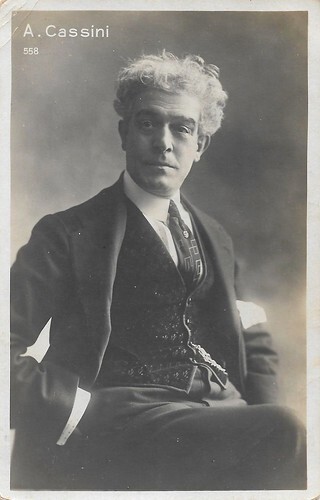
Italian postcard by Ed. G. Vettori, Bologna, no. 558.
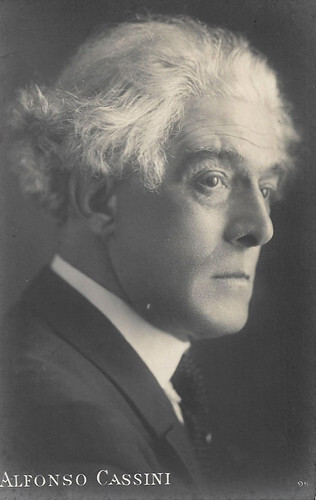
Italian postcard by Fotocelere, Torino, no. 95.
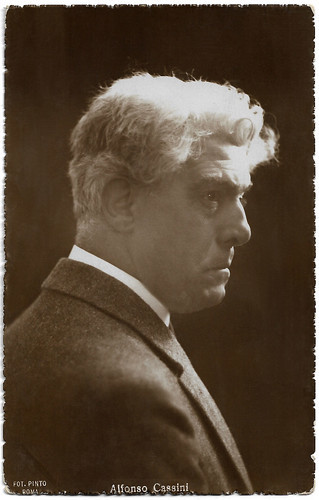
Italian postcard by Ed. Traldi, Milano. Photo: Pinto, Roma.
A bit-part or character actor
Alfonso Cassini was born in Bologna, Italy, in 1858. He began his stage career in 1876.
Over the years Cassini played as 'generico' (bit-part actor) or 'caratterista' (character actor) in the companies of Francesco Gervasi Benincasa, Ermete Novelli and Virgilio Talli.
In 1902, Cassini married actress-director Giulia Cassini-Rizzotto, daughter of a Sicilian stage playwright and actor. With Talli-Gramatica-Calabresi, the couple worked intensively until 1905 and played in numerous productions carried out by the distinguished company. From 1906 to 1912, they acted with the troupe belonging to Tina Di Lorenzo and Armando Falconi .
Between 1912 and 1913 the couple appeared in various heavily emotive melodramas at Latium Film in Rome, a company that had already hired numerous theatre actors. They then moved to Roma Film in 1913, and Etna Film in Catania, Sicily, in 1914, where Giulia became First Actress. Etna Film at the time was considered an excellent production company due to the quality of its equipment and its technical-artistic staff. In 1914 Giulia also opened an acting school in Rome, called Ars Film.
Alfonso Cassini played at Etna in such films as La danza del diavolo (Giuseppe De Liguoro, 1914) and Christus (Giuseppe De Liguoro, 1914) - not to be confused with the Cines production by Antamoro and Guazzzoni. In 1915, when Italy entered World War I, the couple returned to Rome and began to work for Tiber Film. In 1915, he also worked on stage at the Campioni-Baccani company. Until his death, Cassini worked for various film companies such as Cines, Italia Ars Film, Itala Film, and Fert.
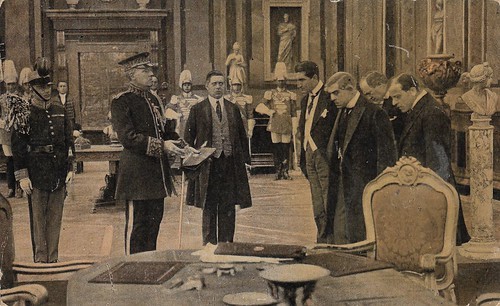
Spanish collector's card by Chocolate Pi, Barcelona, series of 6 cards, card no. 4. Photo: J. Verdaguer / Tiber Film. Ignazio Lupi (left) and Alfonso Cassini as the Lord Chancellor (the blond, elder man right) in Il potere sovrano (Baldassarre Negroni, Percy Nash, 1916). The Spanish title on the cards is Poder Soberano. The man in the middle may be Orlando (as banker Jost).
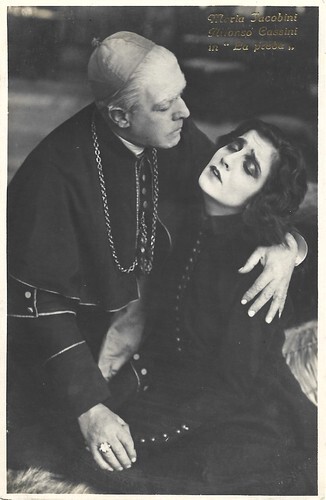
Italian postcard by G.B. Falci, Milano, no. 153. Maria Jacobini and Alfonso Cassini in La preda/The Prey (Guglielmo Zorzi, 1921).
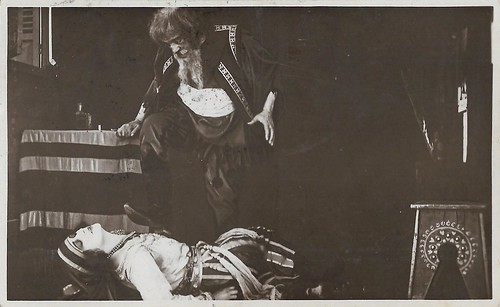
Italian postcard. Photo: Fert. Italia Almirante Manzini and Alfonso Cassini in Zingari (Mario Almirante, 1920). Caption: Jammadar shouts to Vielka: I will crush you!
Father of the divas
Italian critics praised Alfonso Cassini for his masterful and effective performances, his versatility, and his excellent make-up. In 1918 he and his wife attempted to produce and direct films themselves with their own production company Cassini-Rizzotto. Giulia thus directed her own husband in Scugní, which was partly autobiographically based. Afterwards, the couple separated.
Alfonso Cassini then often played the father of the leading characters played by the Italian divas or their male partners. The actor also worked twice with Italia Almirante, in Femmina (Augusto Genina, 1918), and La statua di carne/The Statue of Flesh (Mario Almirante, 1921). With another diva, Hesperia , he appeared in La signora delle camelie/The Lady of the Camelias (Baldassarre Negroni, 1915) and La cuccagna/The Bonanza (Baldassarre Negroni, 1917).
Other diva films in which he acted were Christus (Giulio Antamoro, 1916) with Leda Gys , La falena (Carmine Gallone, 1916) with Lyda Borelli , L'onestà del peccato (Augusto Genina, 1918) with Maria Jacobini , Zoya (Giulio Antamoro, 1920) with Diana Karenne , and La preda/The prey (Guglielmo Zorzi, 1920) with Maria Jacobini.
He also played Diomira Jacobini 's Robinson Crusoe-like father in L'isola della felicità/The Island of Happiness (Luciano Doria, 1921). Finally, he had a major part as the poor elderly newsagent 'Papa Re' in the Luigi Pirandello adaptation Lo scaldino (Augusto Genina, 1920), starring Kally Sambuccini in what she later remembered as her best film.
Alfonso Cassini died in Rome, in 1921. All in all, he acted in some 70 films. Cassini married actress-director Giulia Cassini-Rizzotto in 1902, and they had two children together.
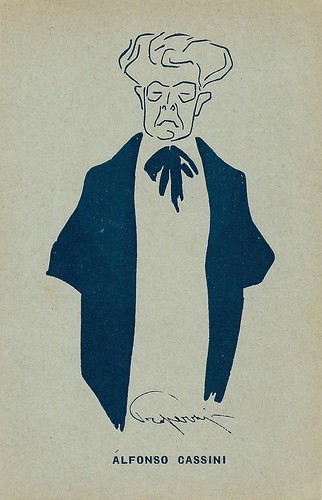
Italian postcard. Caricature by Sandro Properzi for Le Maschere, Rome.
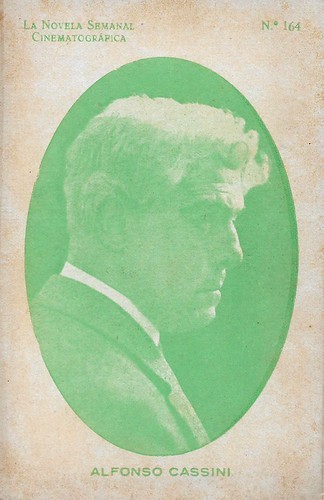
Spanish collectors card by La Novela Semanal Cinematográfica, no. 164.
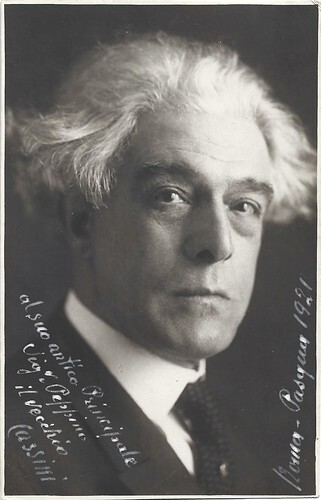
Italian postcard. Sent by mail in Rome, Easter 1921.
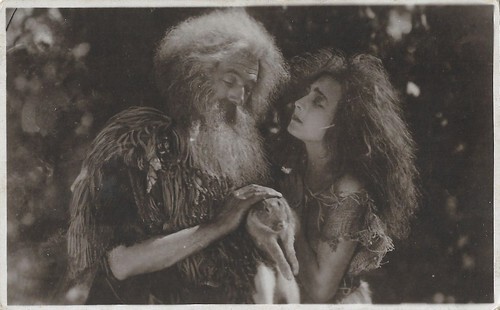
Italian postcard. Photo: Fert Film. Diomira Jacobini and Alfonso Cassini in L'isola della felicità/The Island of Happiness (Luciano Doria, 1921). Caption: The happiness of a simple life. While the back of the card erroneously identifies the man as Alberto Collo , it is Alfonso Cassini whom we see here. He plays the father of the main character, the young woman Magala, who lives on a deserted island.
Sources: Alessandro Faccioli and Marzia Maino (Women Film Pioneers Project). Wikipedia (Italian) and .

Italian postcard by Ed. G. Vettori, Bologna, no. 558.

Italian postcard by Fotocelere, Torino, no. 95.

Italian postcard by Ed. Traldi, Milano. Photo: Pinto, Roma.
A bit-part or character actor
Alfonso Cassini was born in Bologna, Italy, in 1858. He began his stage career in 1876.
Over the years Cassini played as 'generico' (bit-part actor) or 'caratterista' (character actor) in the companies of Francesco Gervasi Benincasa, Ermete Novelli and Virgilio Talli.
In 1902, Cassini married actress-director Giulia Cassini-Rizzotto, daughter of a Sicilian stage playwright and actor. With Talli-Gramatica-Calabresi, the couple worked intensively until 1905 and played in numerous productions carried out by the distinguished company. From 1906 to 1912, they acted with the troupe belonging to Tina Di Lorenzo and Armando Falconi .
Between 1912 and 1913 the couple appeared in various heavily emotive melodramas at Latium Film in Rome, a company that had already hired numerous theatre actors. They then moved to Roma Film in 1913, and Etna Film in Catania, Sicily, in 1914, where Giulia became First Actress. Etna Film at the time was considered an excellent production company due to the quality of its equipment and its technical-artistic staff. In 1914 Giulia also opened an acting school in Rome, called Ars Film.
Alfonso Cassini played at Etna in such films as La danza del diavolo (Giuseppe De Liguoro, 1914) and Christus (Giuseppe De Liguoro, 1914) - not to be confused with the Cines production by Antamoro and Guazzzoni. In 1915, when Italy entered World War I, the couple returned to Rome and began to work for Tiber Film. In 1915, he also worked on stage at the Campioni-Baccani company. Until his death, Cassini worked for various film companies such as Cines, Italia Ars Film, Itala Film, and Fert.

Spanish collector's card by Chocolate Pi, Barcelona, series of 6 cards, card no. 4. Photo: J. Verdaguer / Tiber Film. Ignazio Lupi (left) and Alfonso Cassini as the Lord Chancellor (the blond, elder man right) in Il potere sovrano (Baldassarre Negroni, Percy Nash, 1916). The Spanish title on the cards is Poder Soberano. The man in the middle may be Orlando (as banker Jost).

Italian postcard by G.B. Falci, Milano, no. 153. Maria Jacobini and Alfonso Cassini in La preda/The Prey (Guglielmo Zorzi, 1921).

Italian postcard. Photo: Fert. Italia Almirante Manzini and Alfonso Cassini in Zingari (Mario Almirante, 1920). Caption: Jammadar shouts to Vielka: I will crush you!
Father of the divas
Italian critics praised Alfonso Cassini for his masterful and effective performances, his versatility, and his excellent make-up. In 1918 he and his wife attempted to produce and direct films themselves with their own production company Cassini-Rizzotto. Giulia thus directed her own husband in Scugní, which was partly autobiographically based. Afterwards, the couple separated.
Alfonso Cassini then often played the father of the leading characters played by the Italian divas or their male partners. The actor also worked twice with Italia Almirante, in Femmina (Augusto Genina, 1918), and La statua di carne/The Statue of Flesh (Mario Almirante, 1921). With another diva, Hesperia , he appeared in La signora delle camelie/The Lady of the Camelias (Baldassarre Negroni, 1915) and La cuccagna/The Bonanza (Baldassarre Negroni, 1917).
Other diva films in which he acted were Christus (Giulio Antamoro, 1916) with Leda Gys , La falena (Carmine Gallone, 1916) with Lyda Borelli , L'onestà del peccato (Augusto Genina, 1918) with Maria Jacobini , Zoya (Giulio Antamoro, 1920) with Diana Karenne , and La preda/The prey (Guglielmo Zorzi, 1920) with Maria Jacobini.
He also played Diomira Jacobini 's Robinson Crusoe-like father in L'isola della felicità/The Island of Happiness (Luciano Doria, 1921). Finally, he had a major part as the poor elderly newsagent 'Papa Re' in the Luigi Pirandello adaptation Lo scaldino (Augusto Genina, 1920), starring Kally Sambuccini in what she later remembered as her best film.
Alfonso Cassini died in Rome, in 1921. All in all, he acted in some 70 films. Cassini married actress-director Giulia Cassini-Rizzotto in 1902, and they had two children together.

Italian postcard. Caricature by Sandro Properzi for Le Maschere, Rome.

Spanish collectors card by La Novela Semanal Cinematográfica, no. 164.

Italian postcard. Sent by mail in Rome, Easter 1921.

Italian postcard. Photo: Fert Film. Diomira Jacobini and Alfonso Cassini in L'isola della felicità/The Island of Happiness (Luciano Doria, 1921). Caption: The happiness of a simple life. While the back of the card erroneously identifies the man as Alberto Collo , it is Alfonso Cassini whom we see here. He plays the father of the main character, the young woman Magala, who lives on a deserted island.
Sources: Alessandro Faccioli and Marzia Maino (Women Film Pioneers Project). Wikipedia (Italian) and .
Published on September 12, 2024 22:00
Paul van Yperen's Blog
- Paul van Yperen's profile
- 13 followers
Paul van Yperen isn't a Goodreads Author
(yet),
but they
do have a blog,
so here are some recent posts imported from
their feed.



